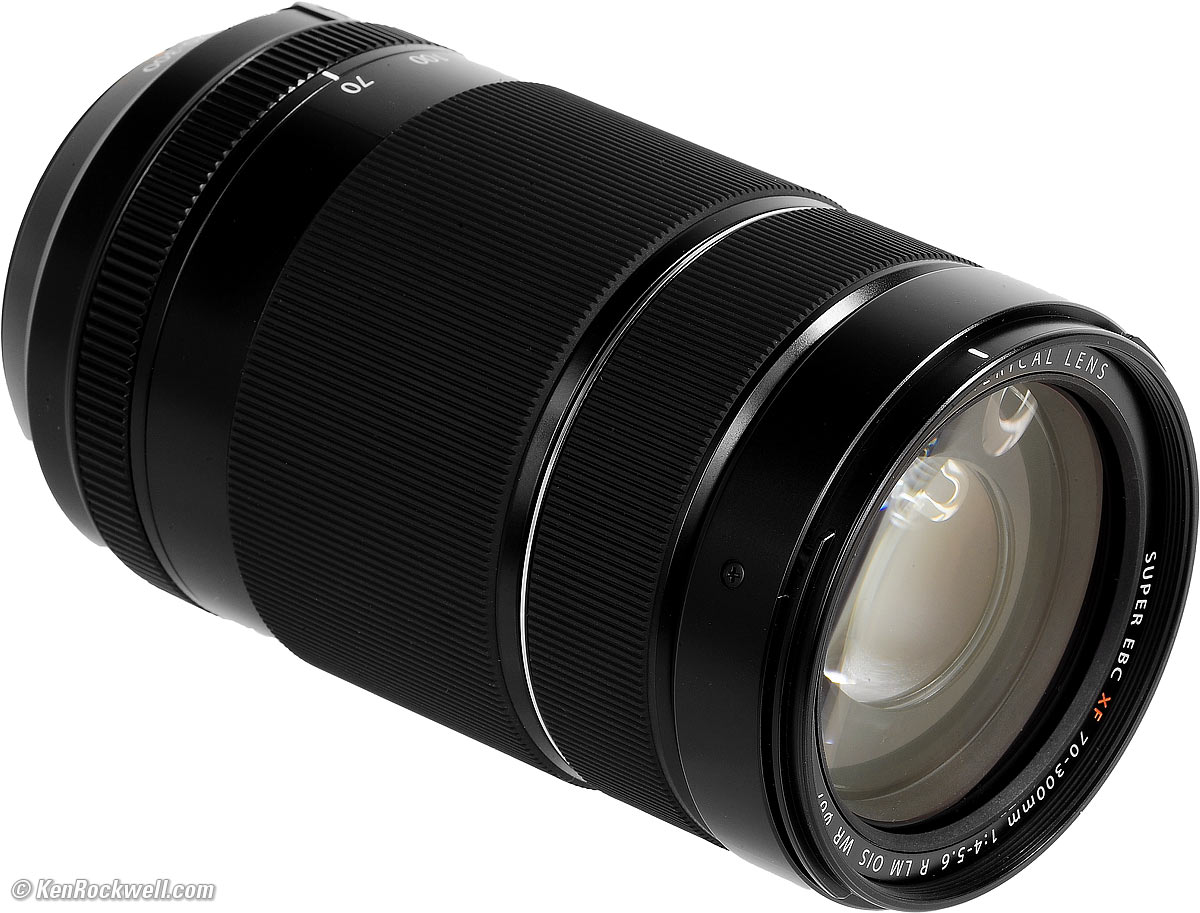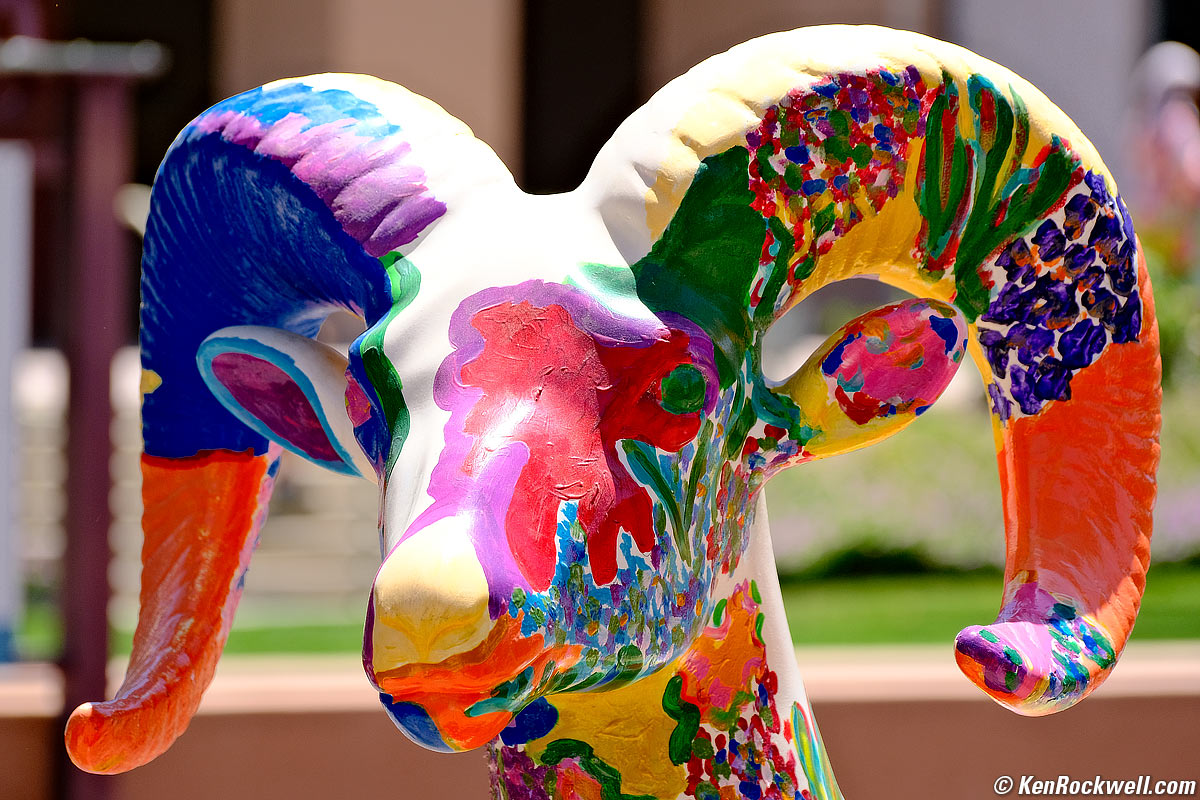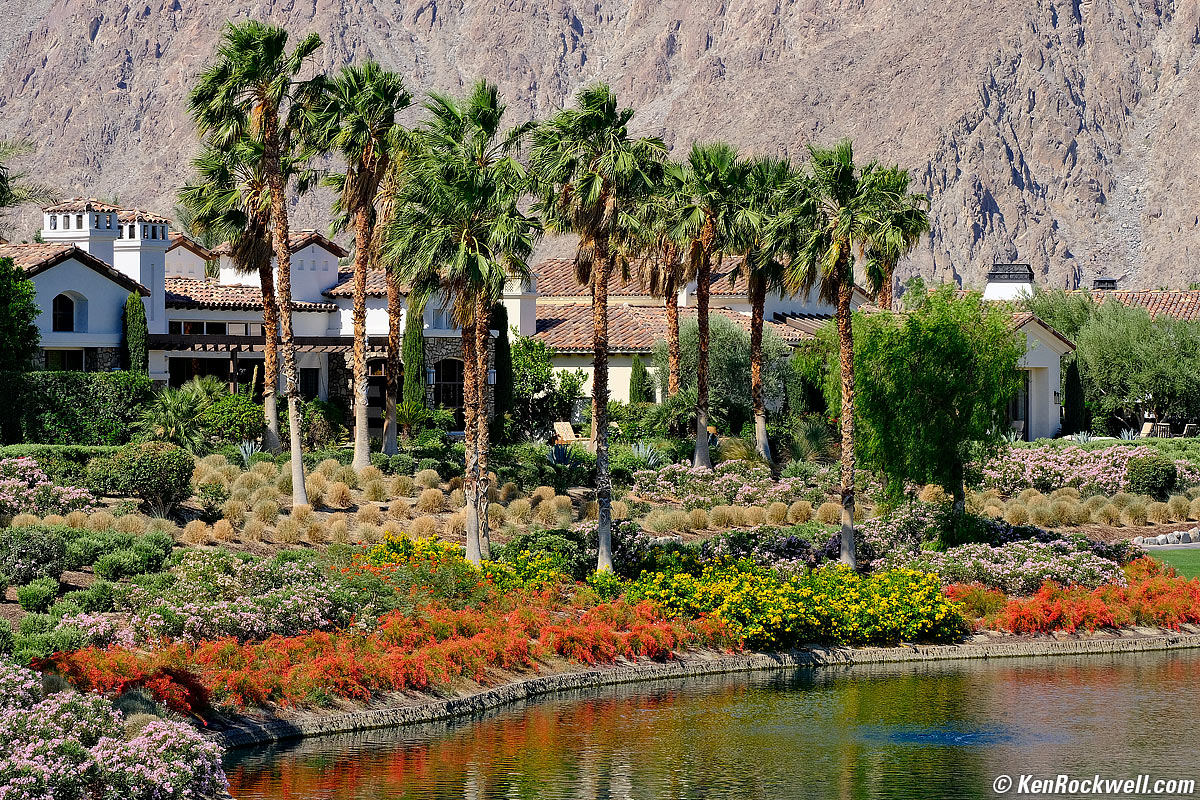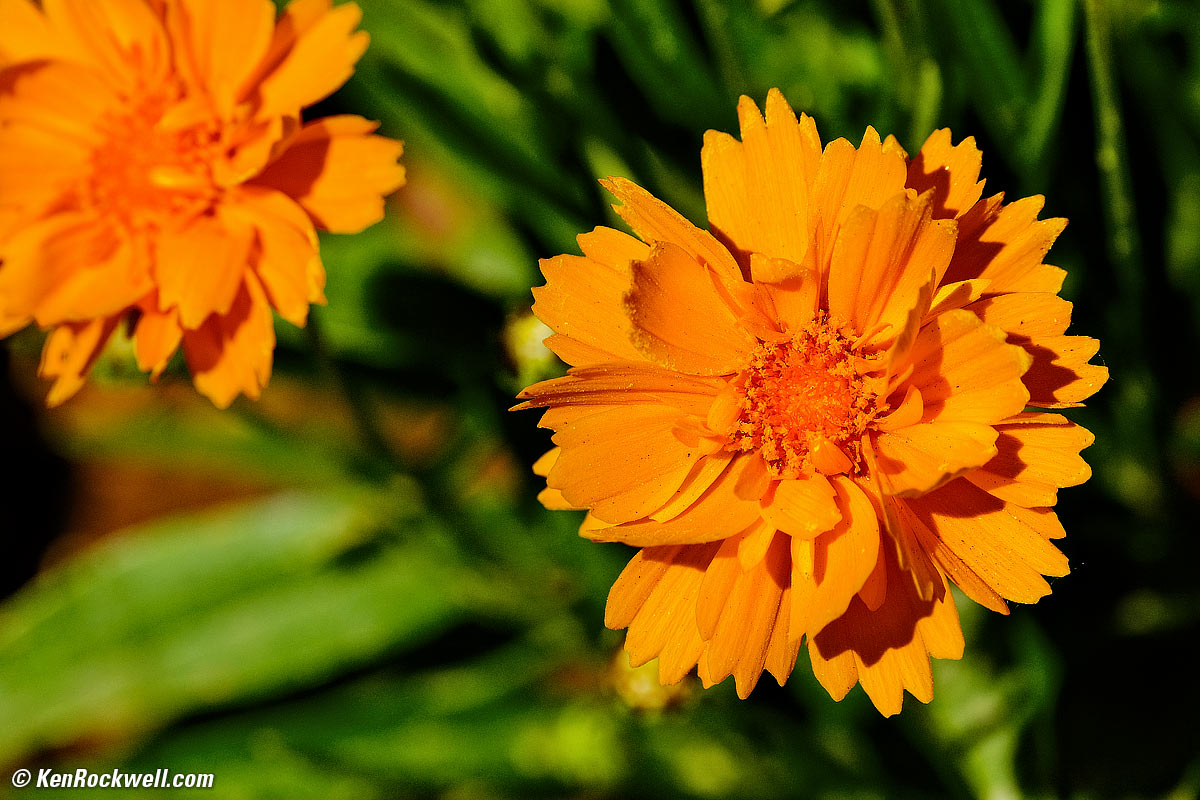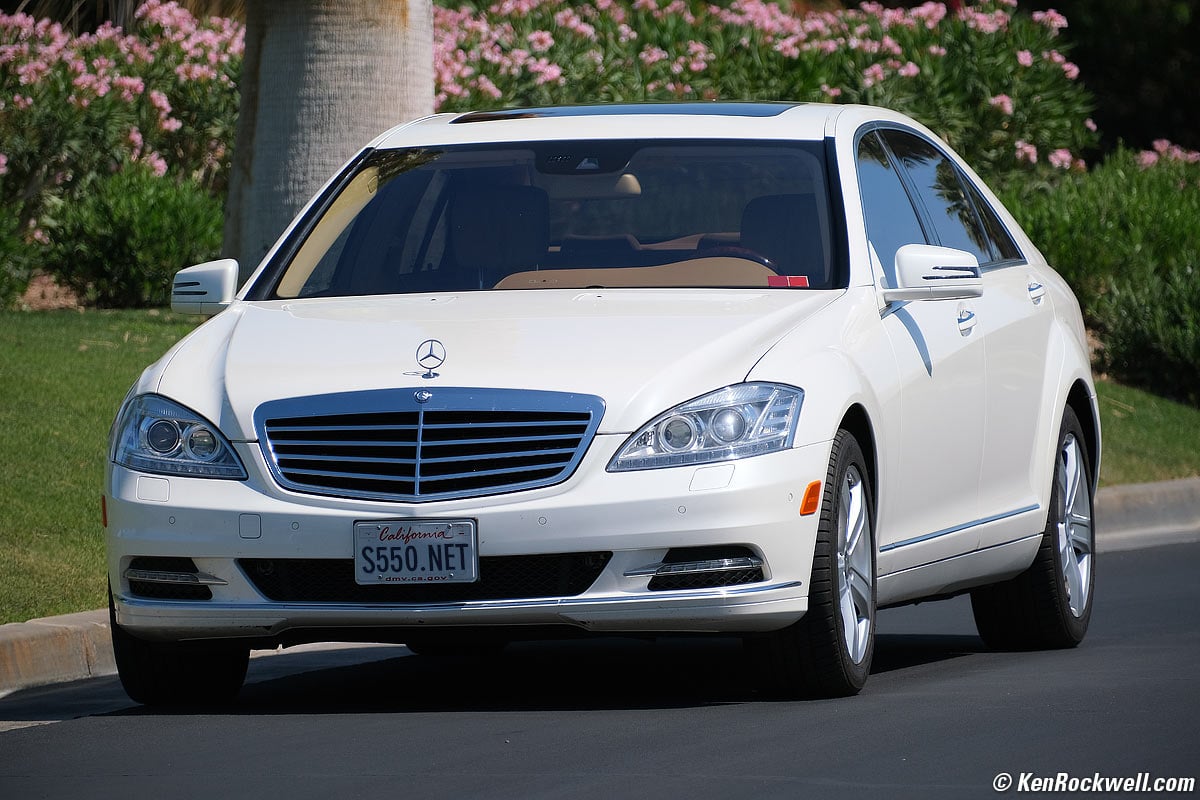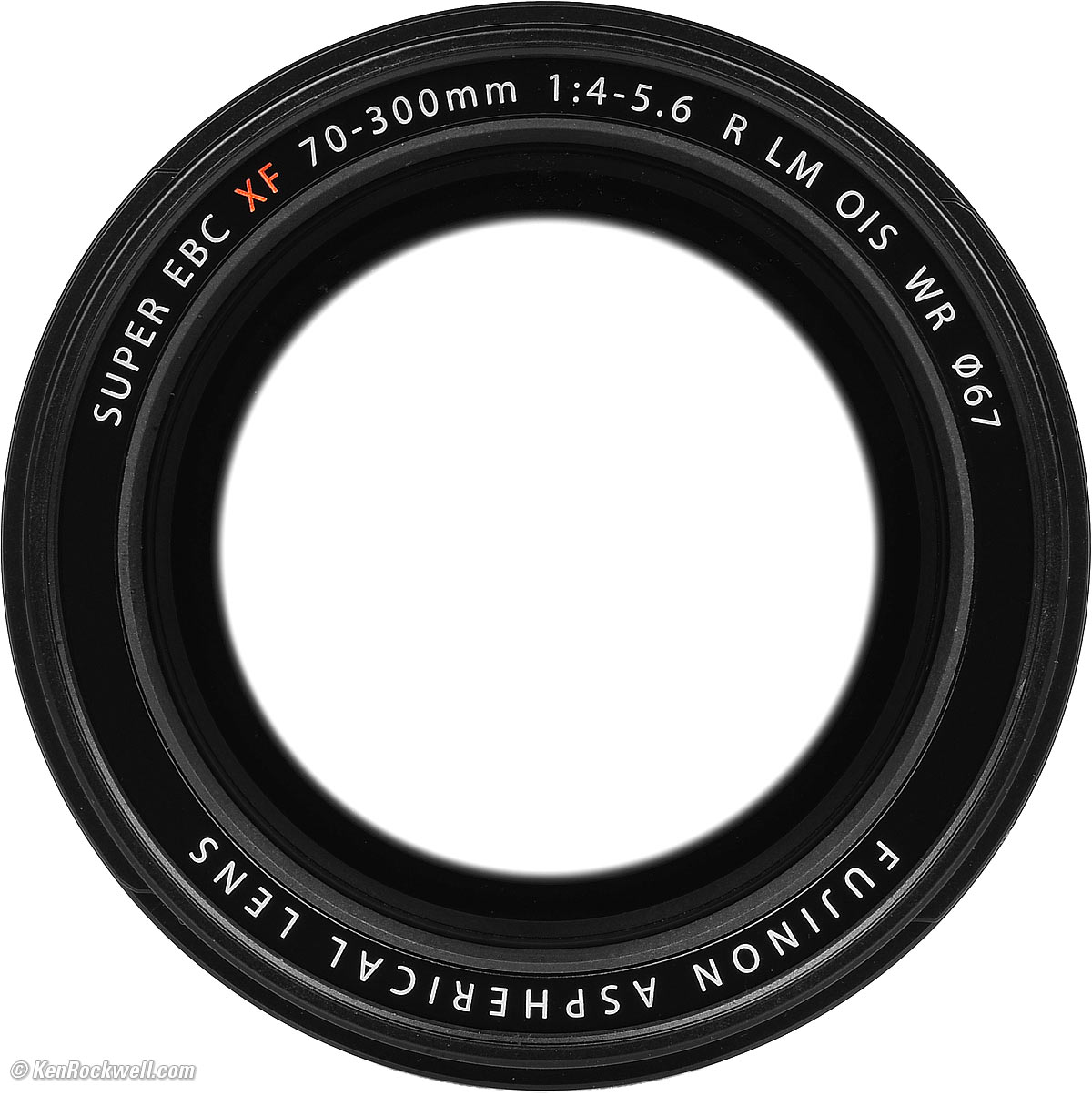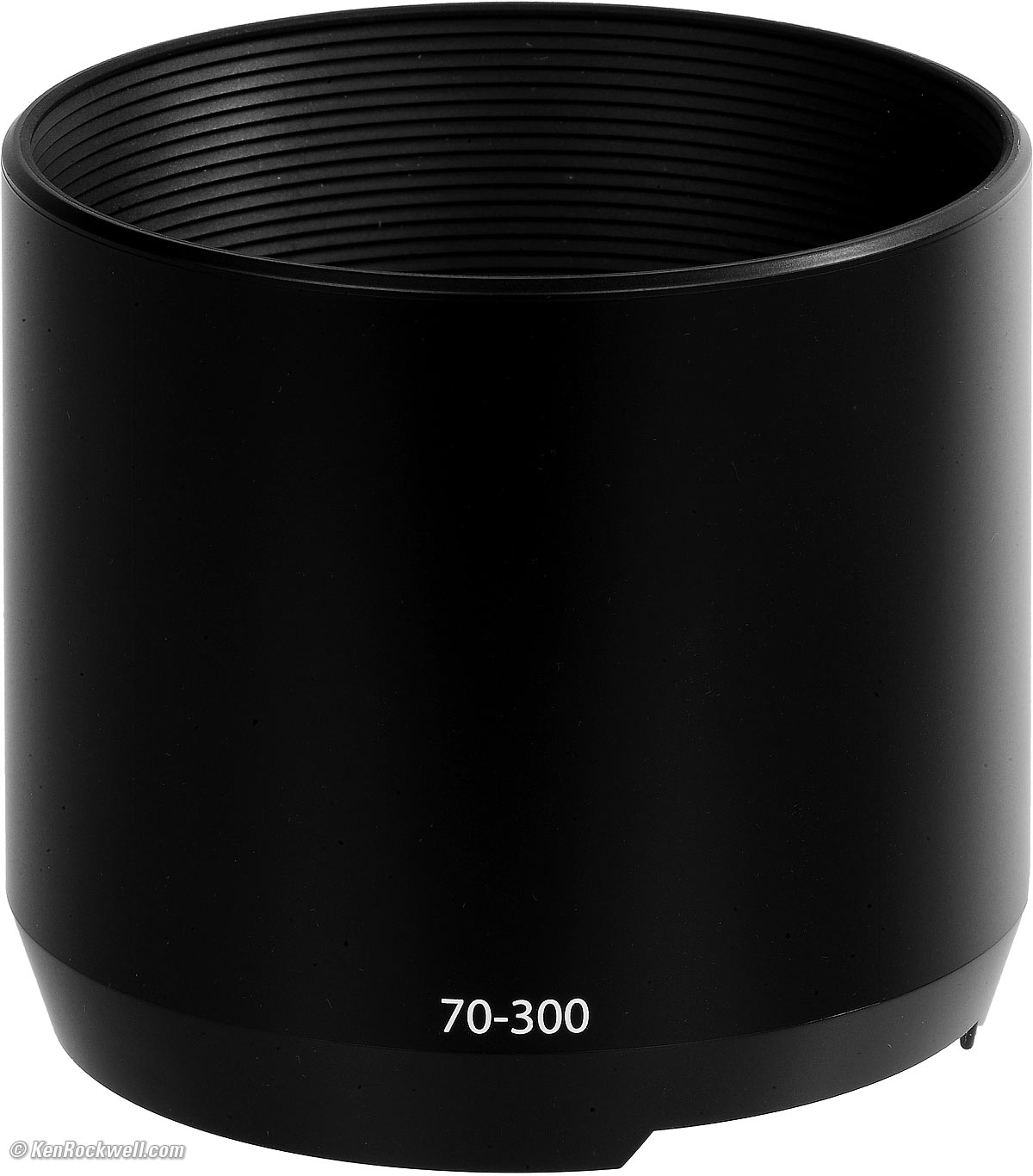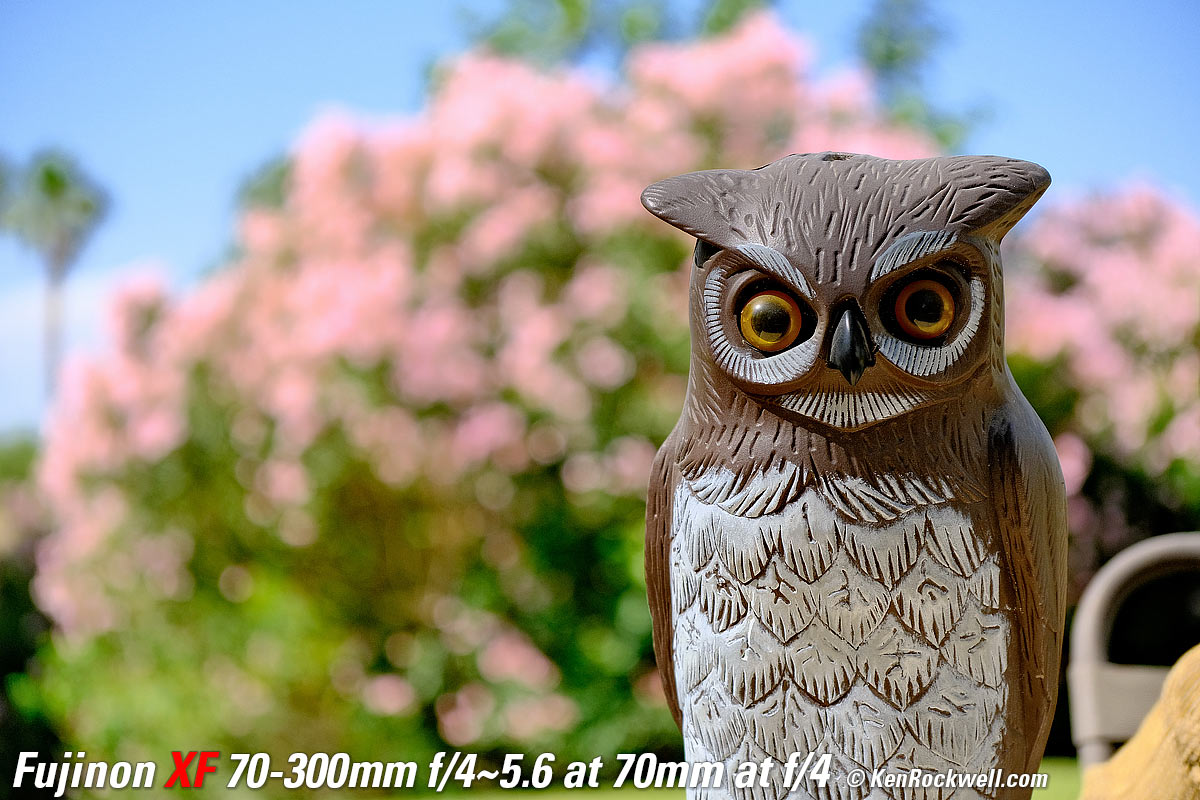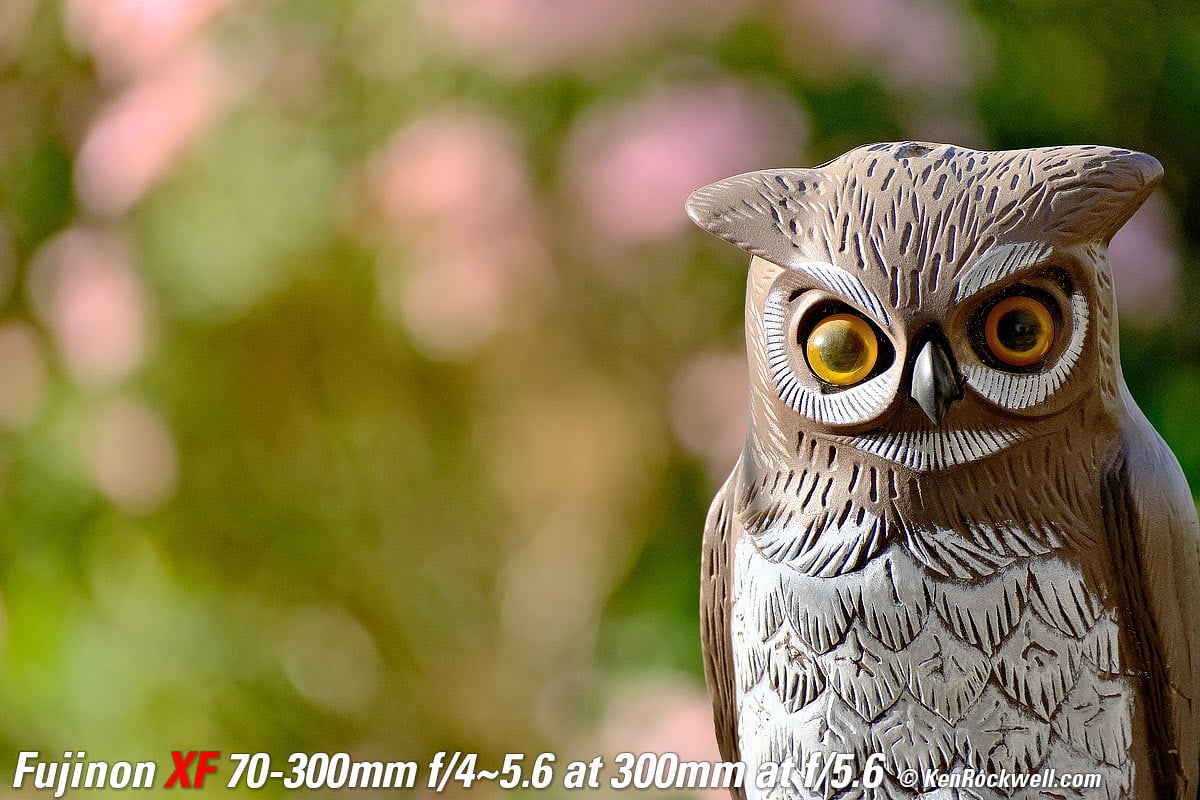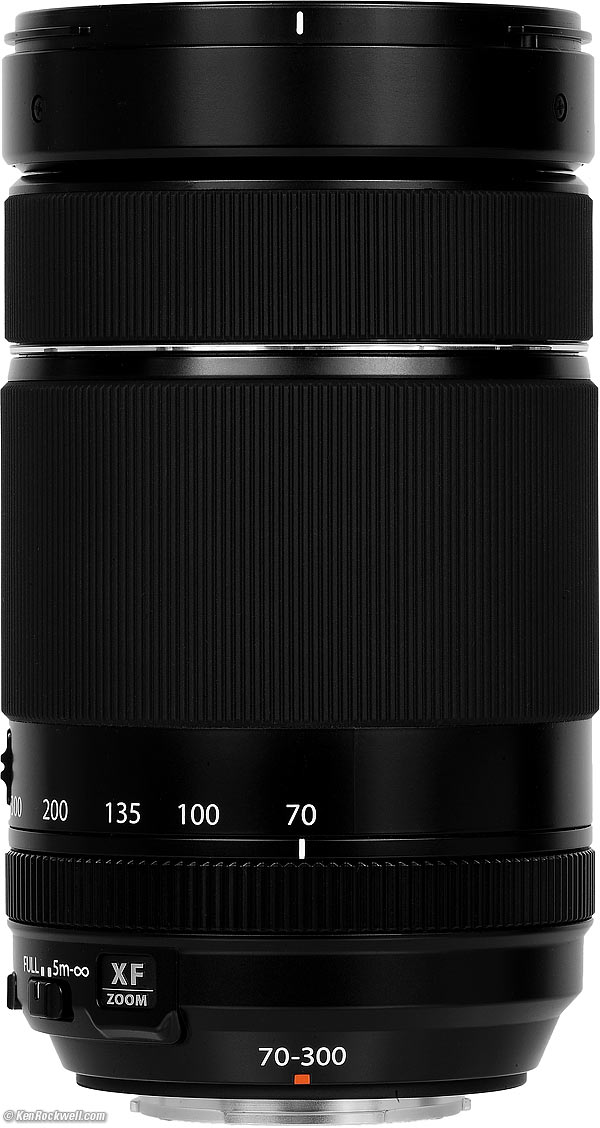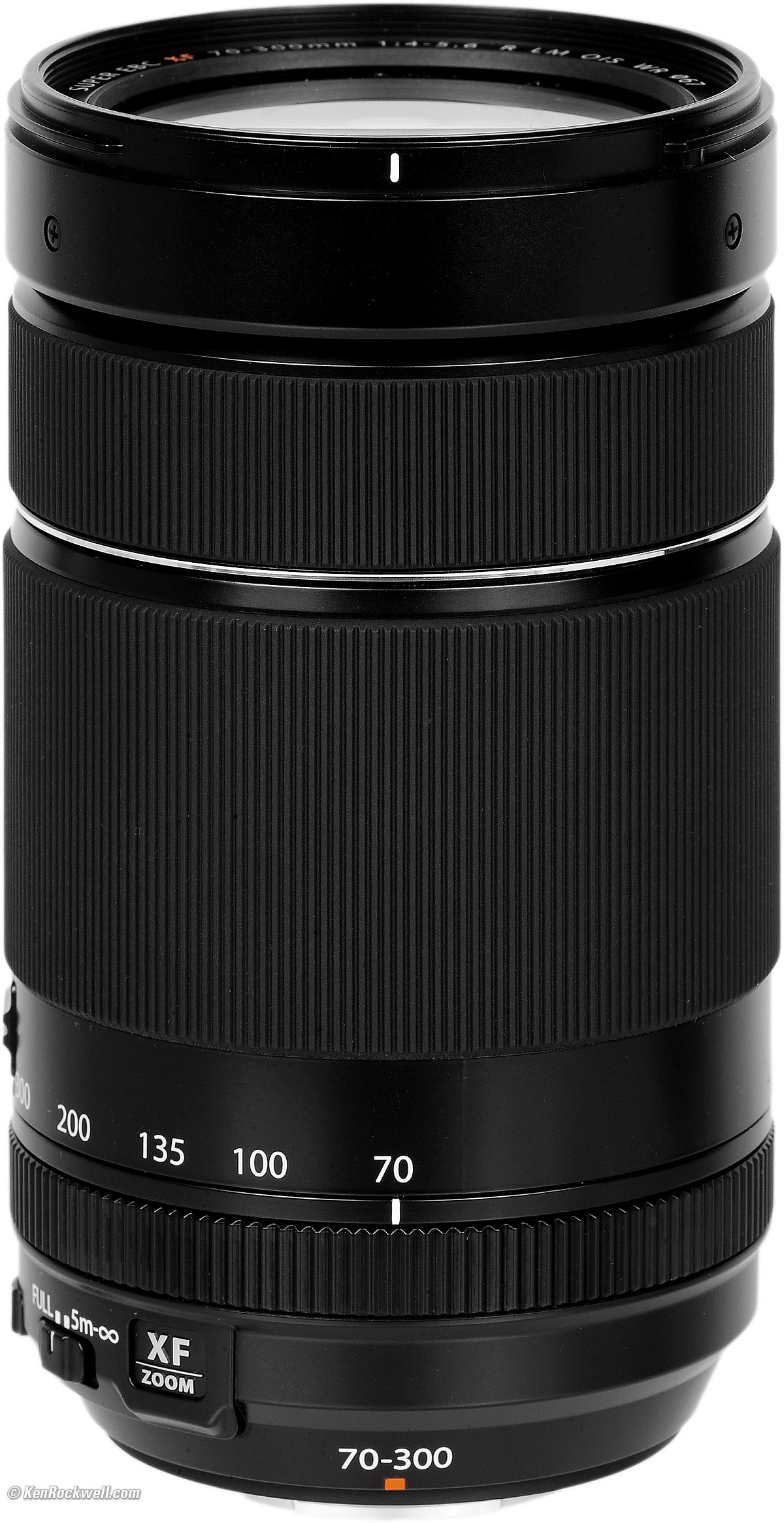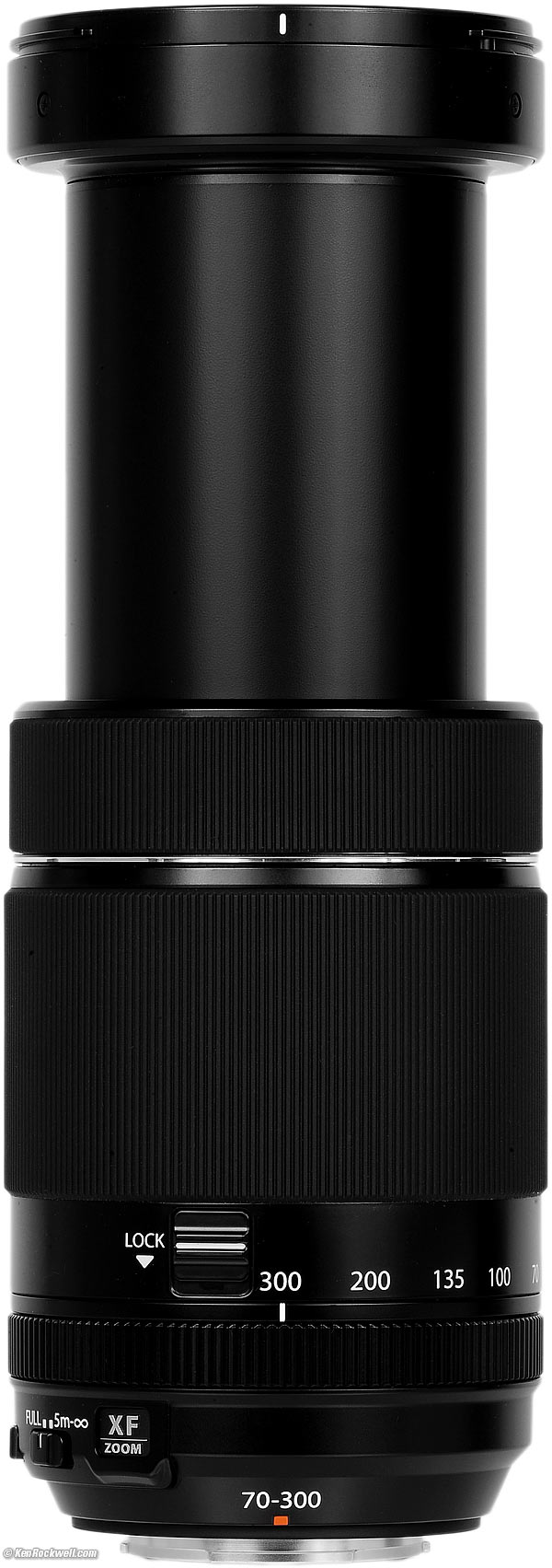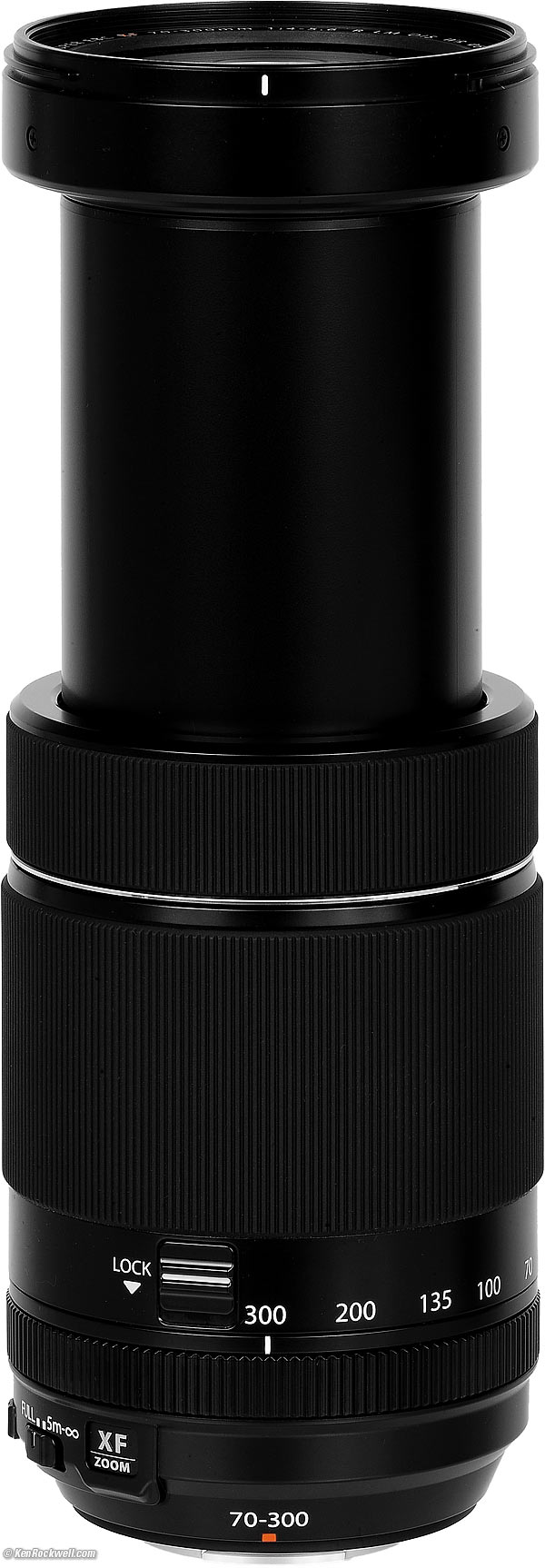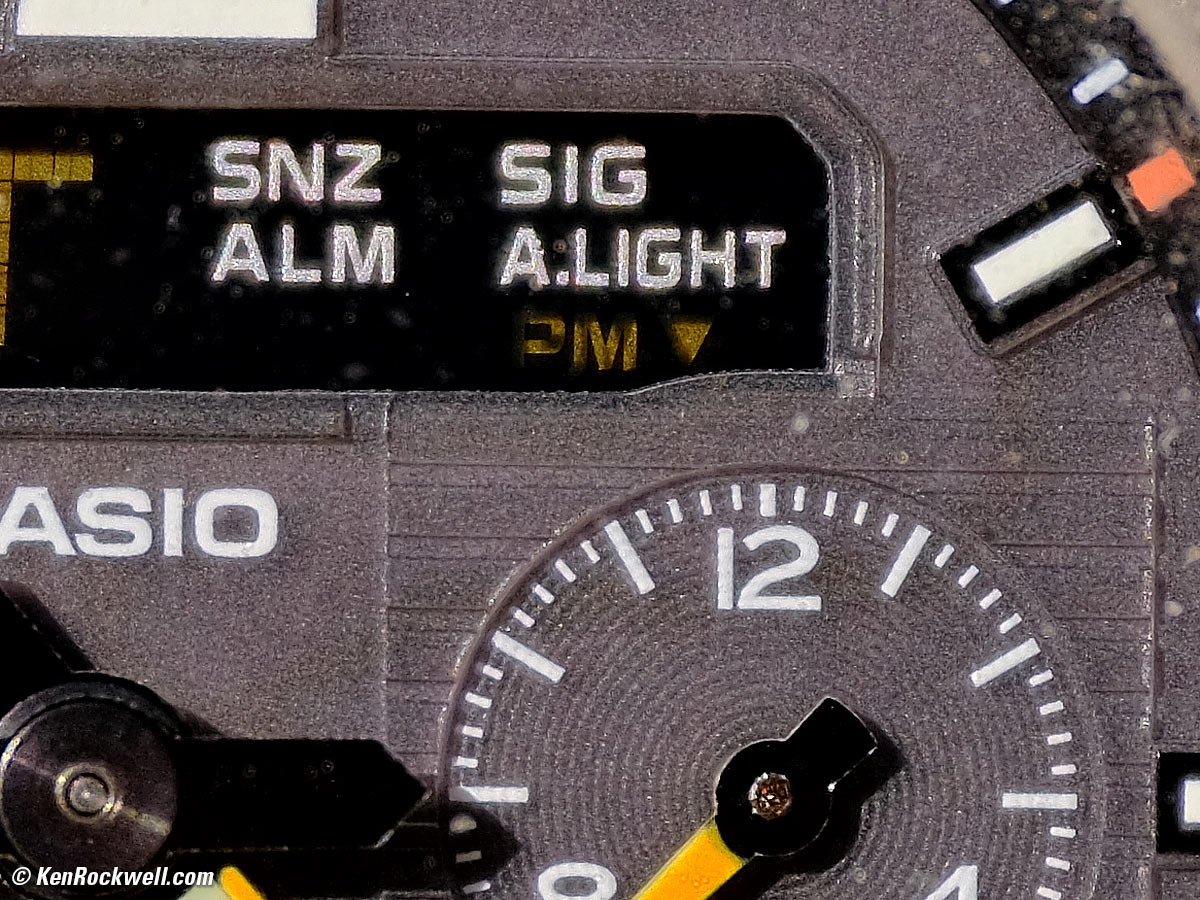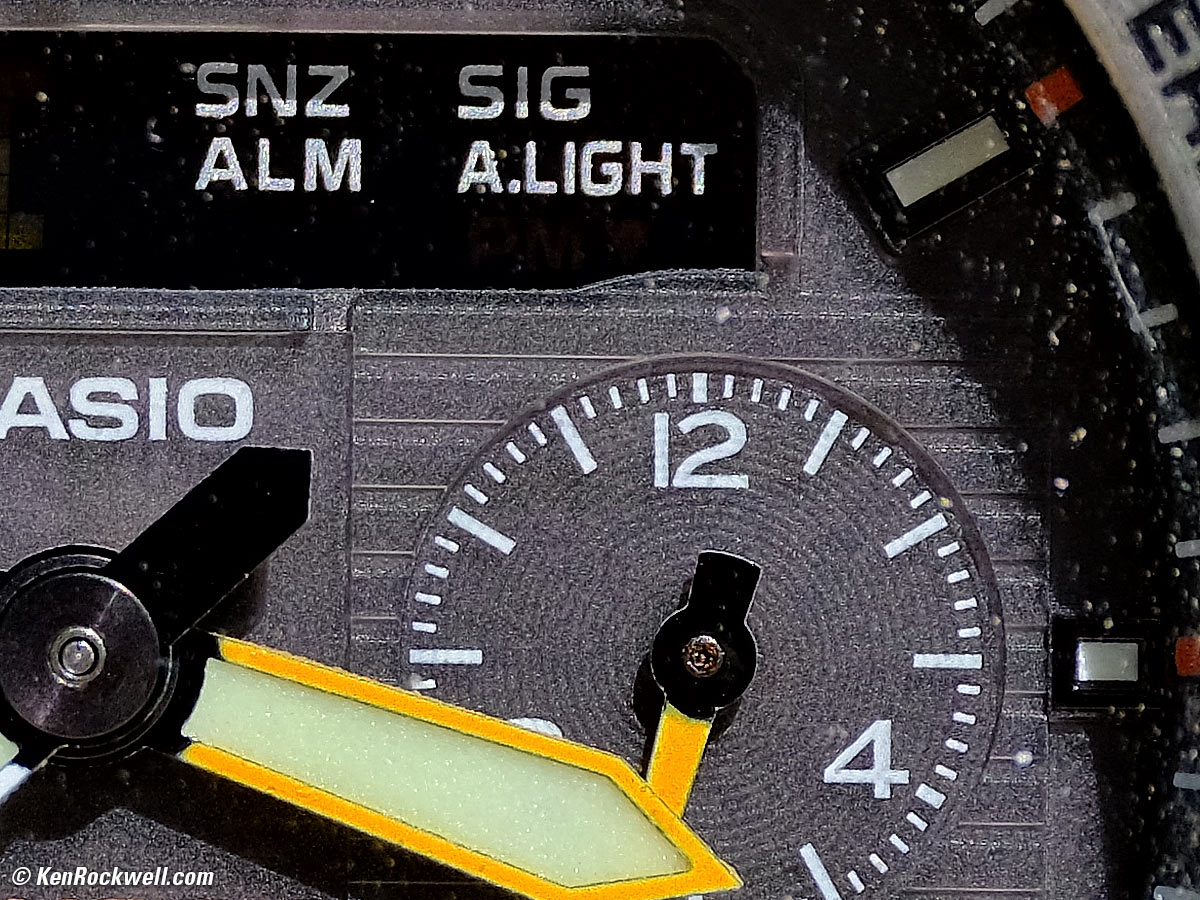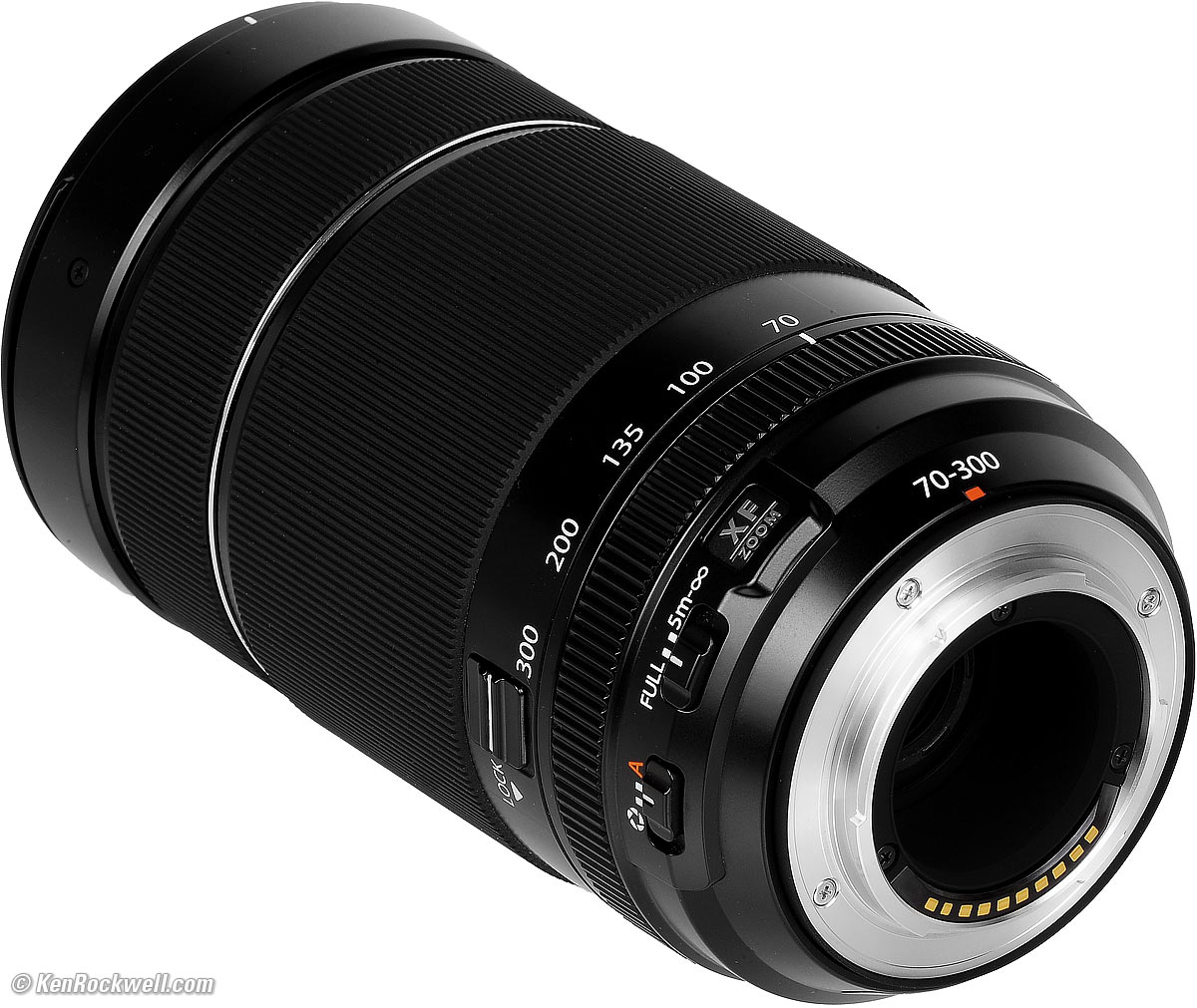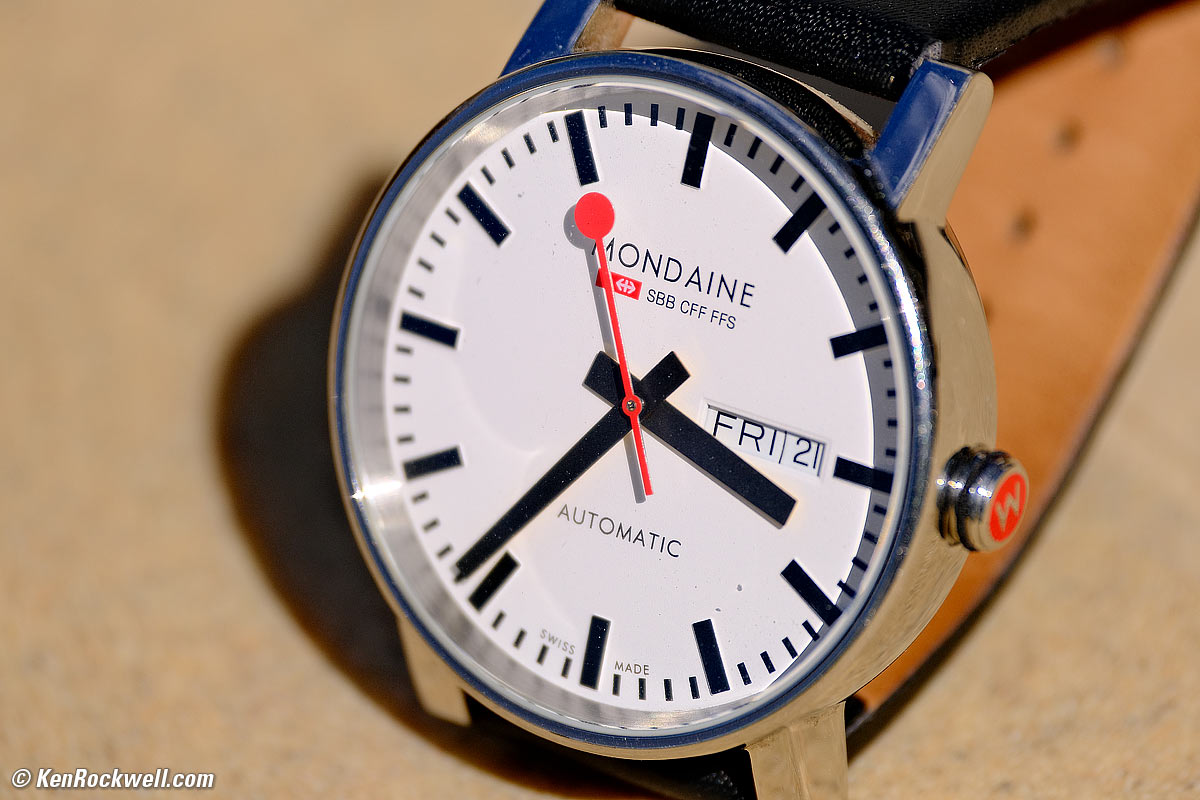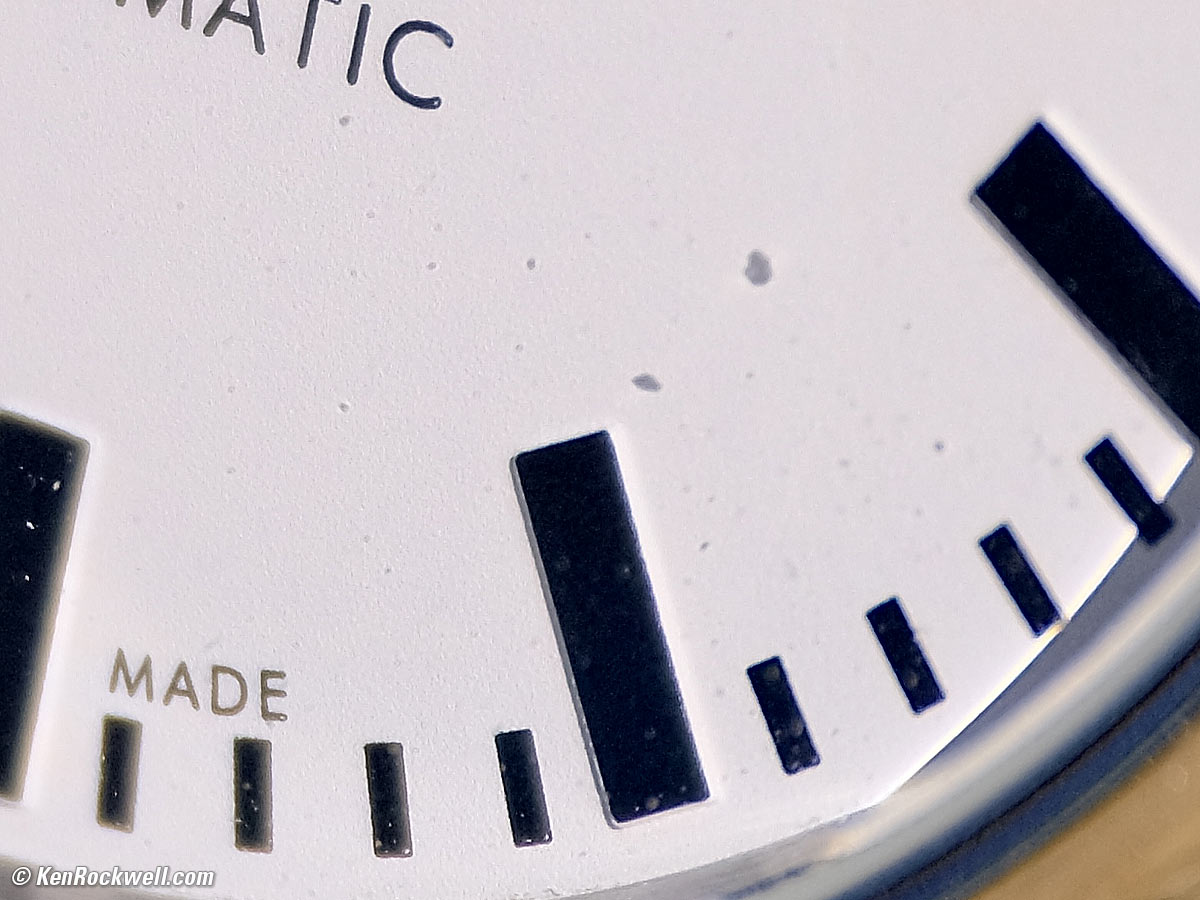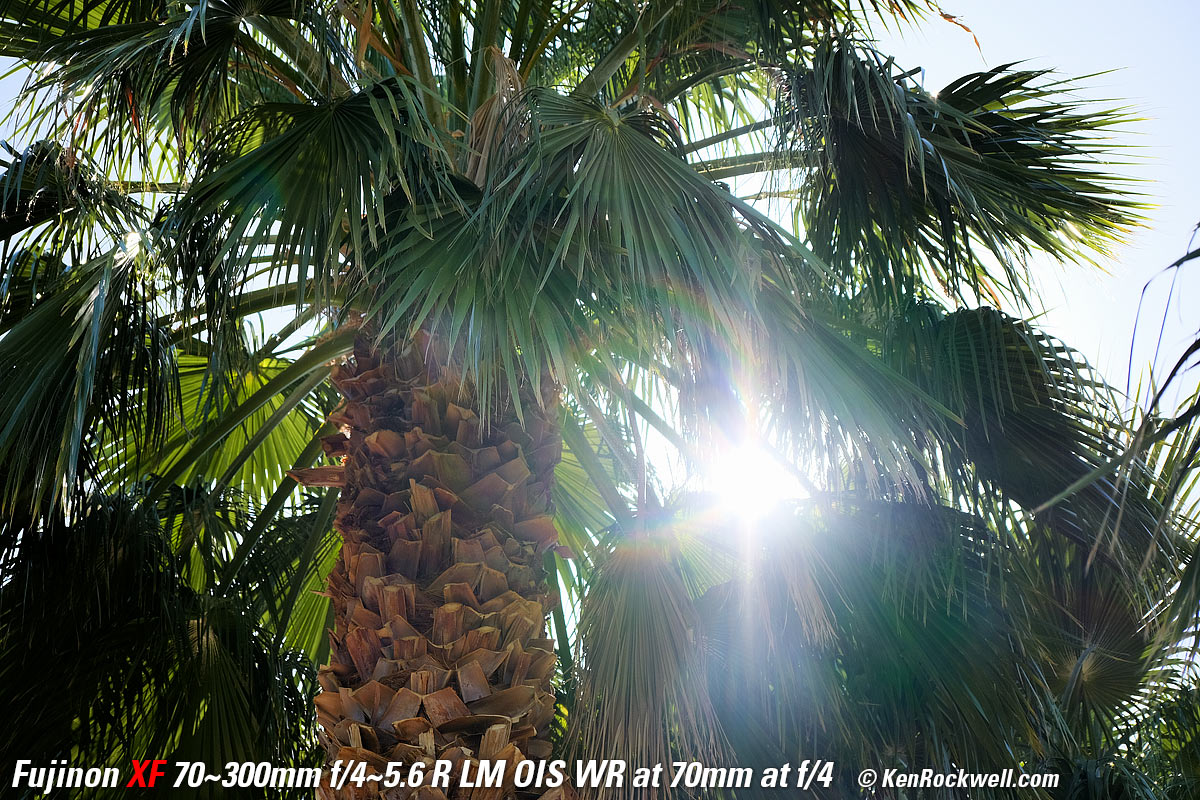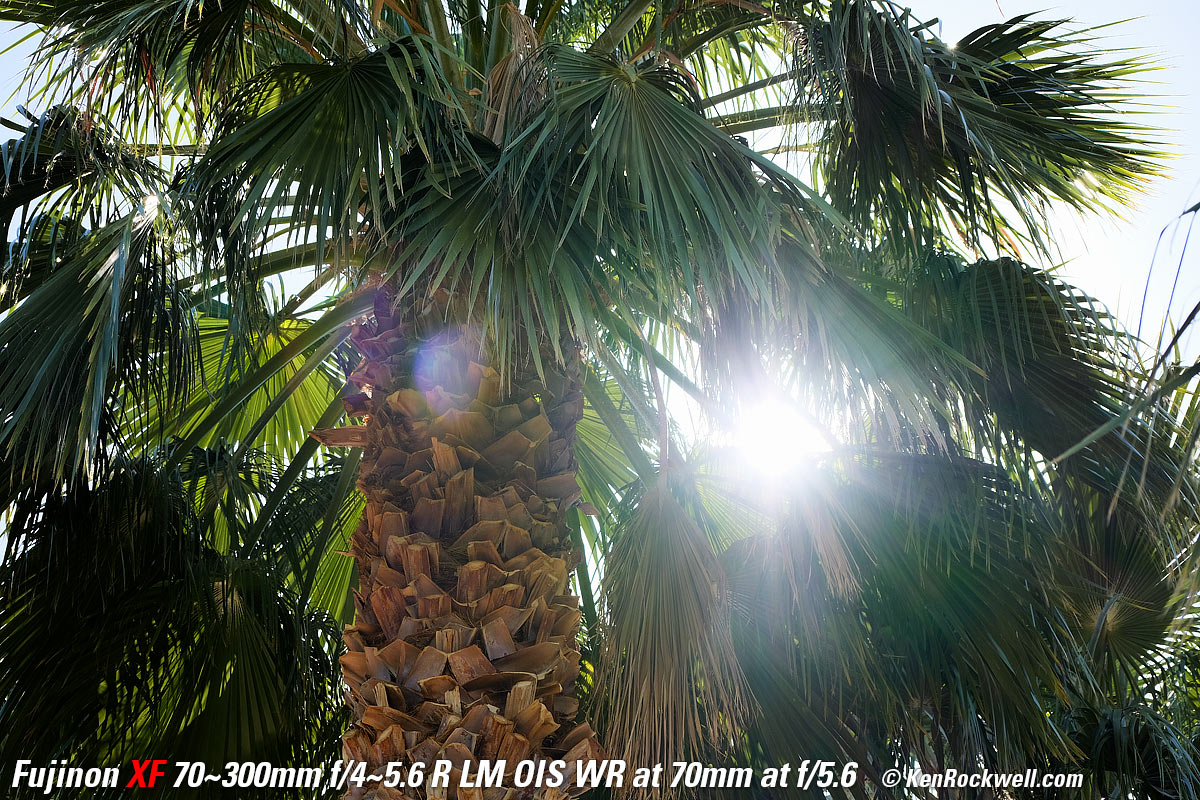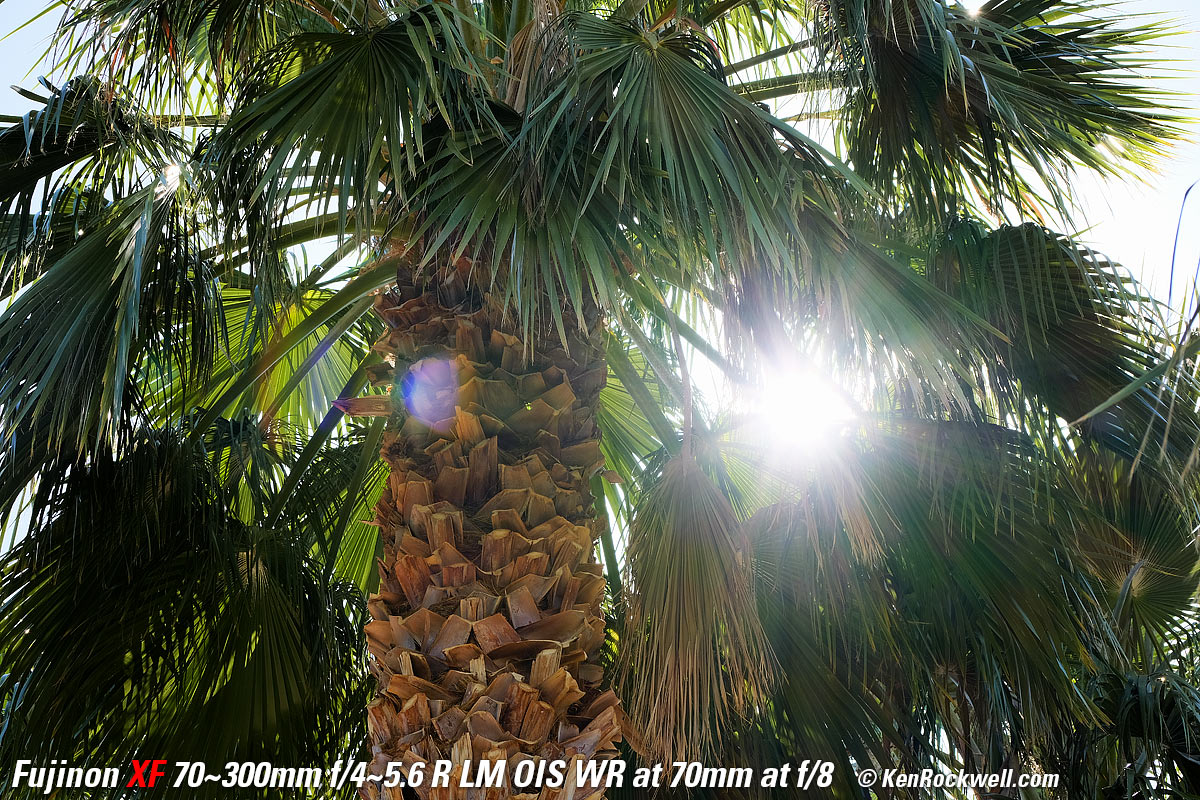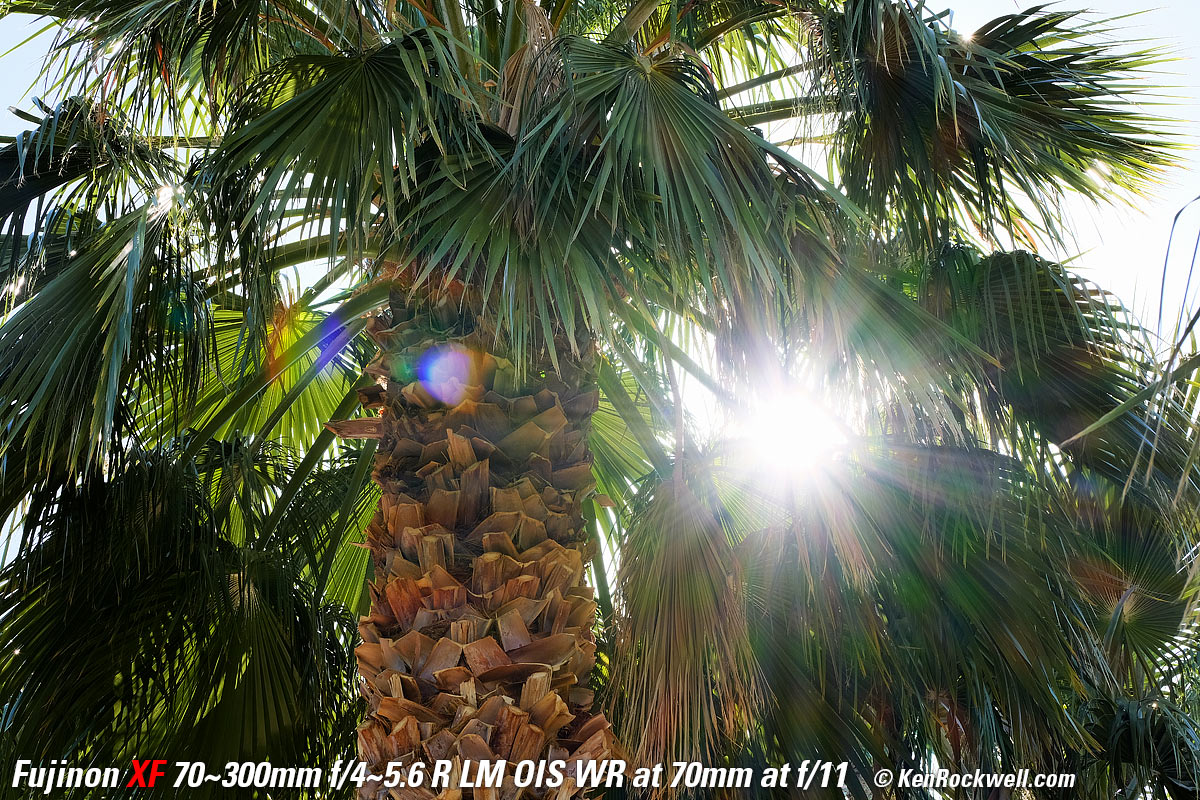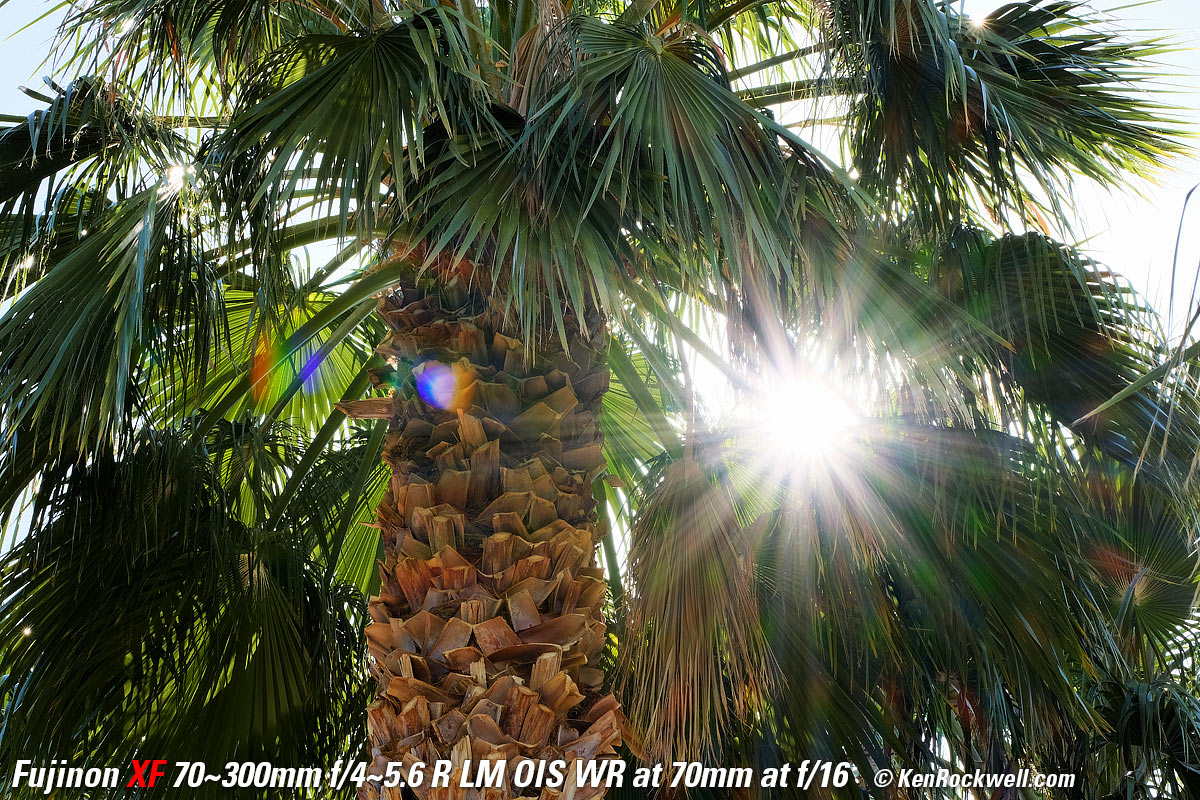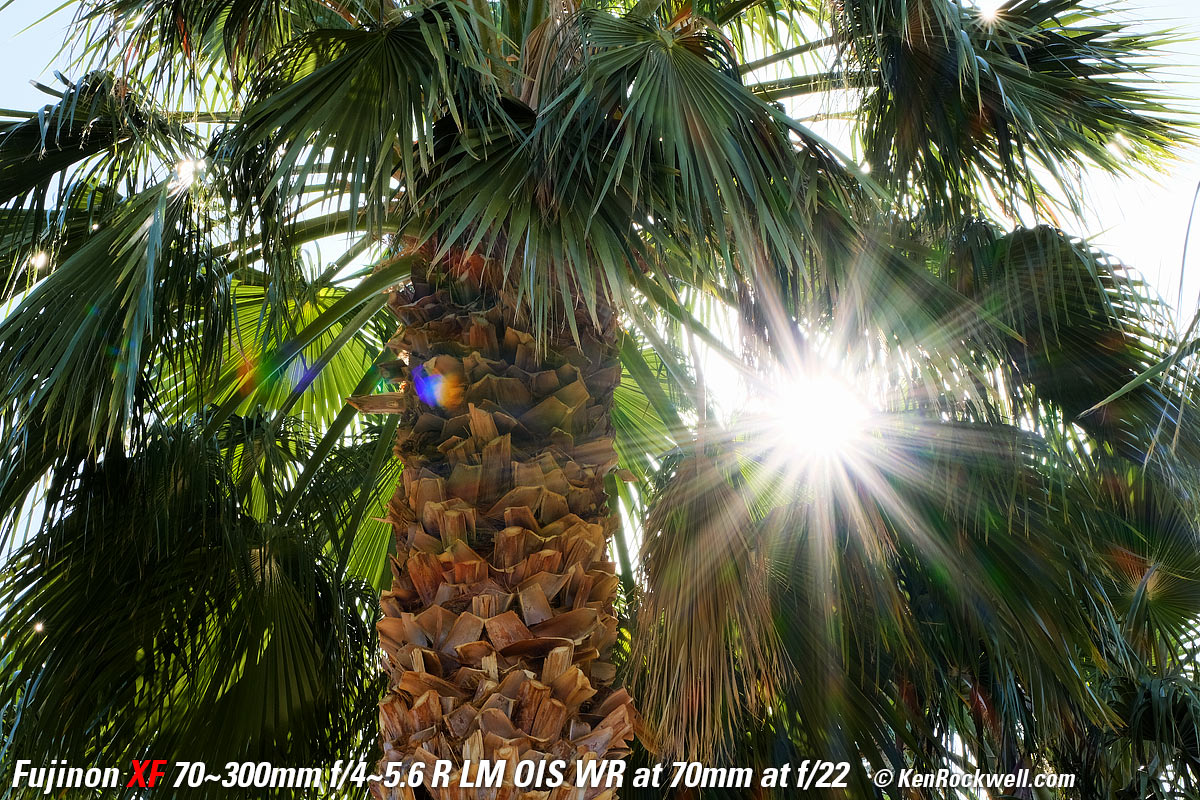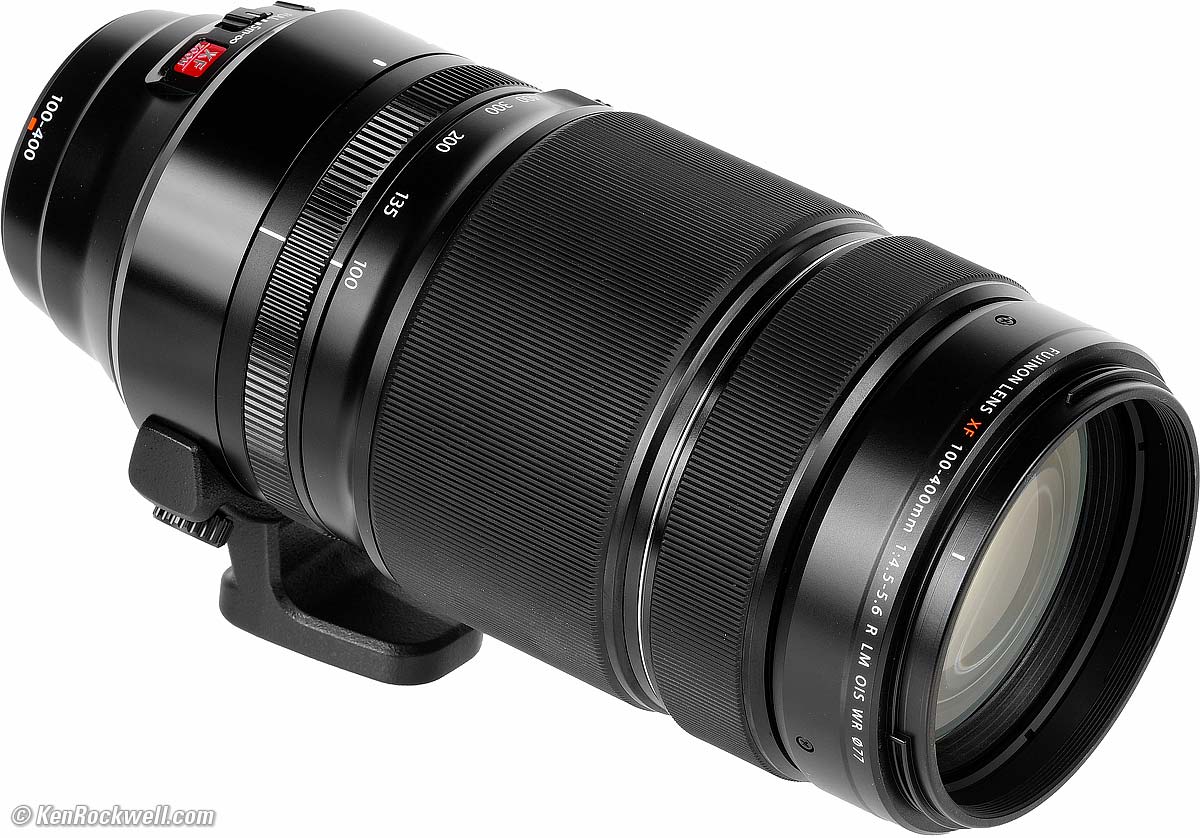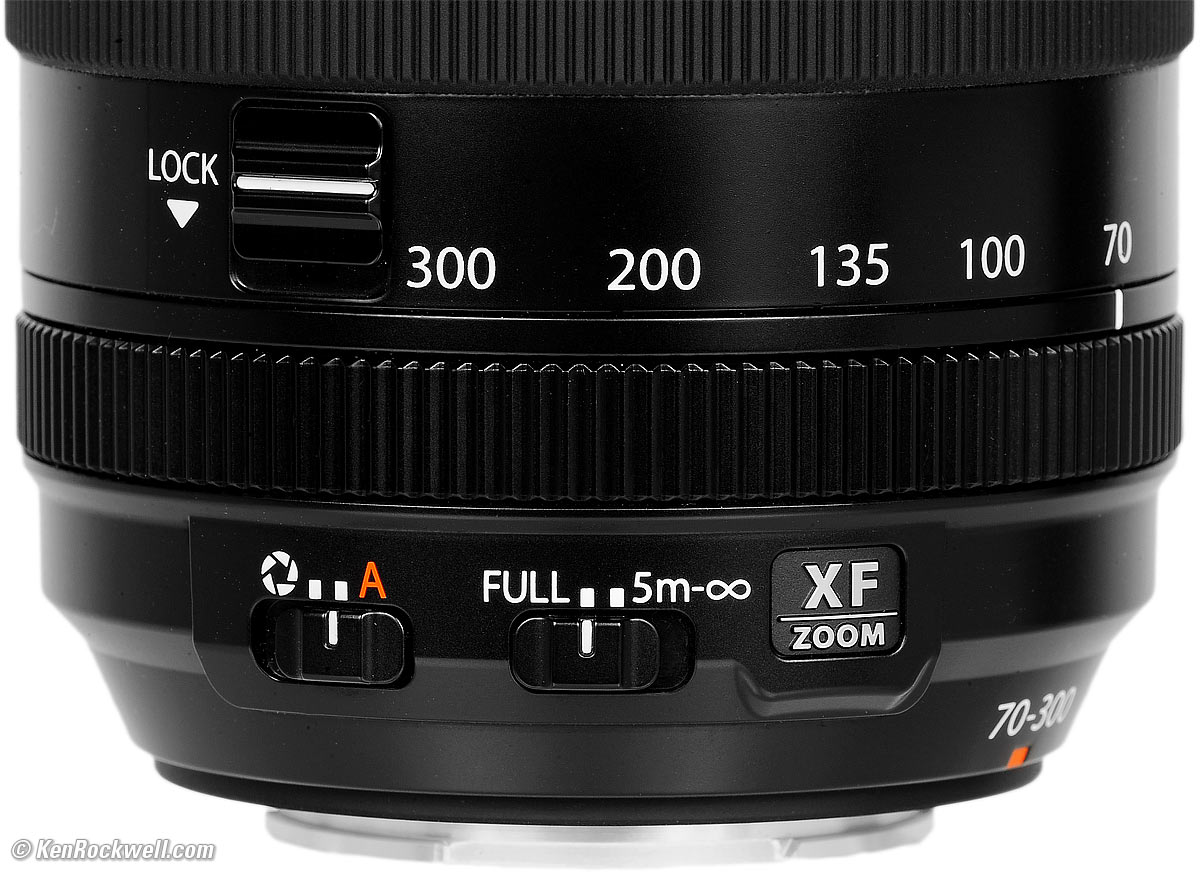Fuji 70-300mm
XF f/4-5.6 R LM OIS WR (105-450mm eq., 2021-)
Sample Images Intro New Good Bad Missing
Specifications Performance Compared
User's Guide Recommendations More
Fujinon XF 70-300mm f/4-5.6 R LM OIS WR (67mm filters, 20.3 oz./576 g, 2.7'/0.83m close focus, $799). bigger. I'd get mine at Adorama, at Amazon or at B&H, or used at eBay if you know How to Win at eBay.
This 100% all-content, junk-free website's biggest source of support is when you use those or any of these links to my personally approved sources I've used myself for way over 100 combined years when you get anything, regardless of the country in which you live — but I receive nothing for my efforts if you get it elsewhere. Fuji does not seal its boxes in any way, so never buy at retail or any other source not on my personally approved list since you'll have no way of knowing if you're missing accessories, getting a defective, damaged, returned, dropped, incomplete, gray-market, store demo or used lens — and all of my personally approved sources allow for 100% cash-back returns for at least 30 days if you don't love your new lens. I've used many of these sources since the 1970s because I can try it in my own hands and return it if I don't love it, and because they ship from secure remote warehouses where no one gets to touch your new lens before you do. Buy only from the approved sources I've used myself for decades for the best prices, service, return policies and selection.
May 2021 Better Pictures Fuji Fuji Lenses Sony LEICA Zeiss Nikon Canon All Reviews
Sample Images top
Sample Images Intro New Good Bad Missing
Specifications Performance Compared
User's Guide Recommendations More
More samples at Bokeh, Macro, Spherochromatism and Sunstars.
These are just snapshots; my real work is in my Gallery. These are all shot hand-held as NORMAL JPGs; no tripods, FINE JPGs or RAW files were used or needed.
Bighorn Sheep, 1:43 PM, 21 May 2021. Fuji X-S10, XF 70-300mm R OIS WR at 127mm wide-open at f/5 at 1/550 at Auto ISO 320, +0.7 stops exposure compensation, (LV 12.0), "Velvia" film simulation, COLOR CHROME EFFECT STRONG, COLOR CHROME FX BLUE STRONG, AUTO White Balance with +1 Red and -1 Blue, 200% Dynamic Range, TONE CURVE: Highlights -1, Shadows -1, COLOR +4, SHARPNESS +4, HIGH ISO NR -5, CLARITY +5, exactly as shot. bigger or camera-original © JPG file.
Cactus, 1:46 PM, 21 May 2021. Fuji X-S10, XF 70-300mm R OIS WR at 300mm wide-open at f/5.6 at 1/850 at Auto ISO 320, +0.7 stops exposure compensation, (LV 13.1), "Velvia" film simulation, COLOR CHROME EFFECT STRONG, COLOR CHROME FX BLUE STRONG, AUTO White Balance with +1 Red and -1 Blue, 200% Dynamic Range, TONE CURVE: Highlights -1, Shadows -1, COLOR +4, SHARPNESS +4, HIGH ISO NR -5, CLARITY +5, Perfectly Clear. bigger or camera-original © JPG file.
Palms and Flowers, 9:44 AM, 22 May 2021. Fuji X-S10, XF 70-300mm R OIS WR at 94mm at f/11 at 1/280 at Auto ISO 320 (LV 13.4), "Velvia" film simulation, COLOR CHROME EFFECT STRONG, COLOR CHROME FX BLUE STRONG, AUTO White Balance with +1 Red and -1 Blue, 200% Dynamic Range, TONE CURVE: Highlights -1, Shadows -1, COLOR +4, SHARPNESS +4, HIGH ISO NR -5, CLARITY +5, exactly as shot. bigger or camera-original © JPG file.
Orange Flowers, 9:46 AM, 22 May 2021. Fuji X-S10, XF 70-300mm R OIS WR at 300mm at f/8 at 1/1,100 at Auto ISO 320 (LV 14.5), "Velvia" film simulation, COLOR CHROME EFFECT STRONG, COLOR CHROME FX BLUE STRONG, AUTO White Balance with +1 Red and -1 Blue, 200% Dynamic Range, TONE CURVE: Highlights -1, Shadows -1, COLOR +4, SHARPNESS +4, HIGH ISO NR -5, CLARITY +5, Perfectly Clear. bigger, full resolution or camera-original © JPG file.
Mercedes S550, 10:33 AM, 17 May 2021. Fuji X-E4, XF 70-300mm R OIS WR at 300mm wide-open at f/5.6 at 1/1,700 at Auto ISO 320, -0.3 stops exposure compensation, (LV 14.0), 200% Auto Dynamic Range, as shot. bigger or full resolution.
Introduction top
Sample Images Intro New Good Bad Missing
Specifications Performance Compared
User's Guide Recommendations More
|
I buy only from these approved sources. I can't vouch for ads below. |
The Fuji XF 70-300mm f/4-5.6 R LM OIS WR is a very useful telephoto for all of Fujifilm's APS-C cameras.
Of course it has fast autofocus, focuses super-close, it's sharp and has Image Stabilization so we can leave our tripods back where they belong in the 1950s.
Its only vices are a lack of a stabilizer switch, and a lack of an AF/MF switch for use on Fuji cameras like the X-S10 and X-E4 that have removed their Focus Mode switches for people who don't actually shoot.
I'd get my XF 70-300mm at Adorama, at Amazon or at B&H, or used at eBay if you know How to Win at eBay.
New intro top
 Fuji's first 70-300mm (105-450mm equivalent) zoom for their APS-C cameras.
Fuji's first 70-300mm (105-450mm equivalent) zoom for their APS-C cameras.
 No more stabilizer switch.
No more stabilizer switch.
 Even though this is a variable-aperture zoom, the minimum aperture is f/22 at all zoom settlings.
Even though this is a variable-aperture zoom, the minimum aperture is f/22 at all zoom settlings.
Good intro top
 Image Stabilization rated 5.5 stops.
Image Stabilization rated 5.5 stops.
 Sharp.
Sharp.
 Practical.
Practical.
 No focus breathing at any focal length.
No focus breathing at any focal length.
 Hood included.
Hood included.
Bad intro top
 Offshored to The Philippines; not made domestically in Japan.
Offshored to The Philippines; not made domestically in Japan.
 No AF/MF switch.
No AF/MF switch.
 No Stabilizer switch.
No Stabilizer switch.
Missing intro top
 No always-responsive instant manual-focus override; but that's a system flaw with all of Fujifilm.
No always-responsive instant manual-focus override; but that's a system flaw with all of Fujifilm.
 No AF/MF switch (not all Fuji cameras have focus mode switches).
No AF/MF switch (not all Fuji cameras have focus mode switches).
 No Stabilizer switch.
No Stabilizer switch.
Specifications top
Sample Images Intro New Good Bad Missing
Specifications Performance Compared
User's Guide Recommendations More
I'd get my XF 70-300mm at Adorama, at Amazon or at B&H, or used at eBay if you know How to Win at eBay.
Name specifications top
Fujifilm calls this the Fujinon Aspherical Lens Super EBC XF 70-300mm f/4-5.6 R LM OIS WR ∅67:
Fujinon is Fujifilm's brand name for all their lenses, scopes and binoculars.
Aspherical means it uses an aspherically-shaped lens element for sharper pictures.
Super EBC is Fujinon's brand of multicoating, standing for Super Electron-Beam Coated.
XF is Fuji's line of good lenses for their X-mount cameras.
R means it has an aperture ring.
LM means Linear (autofocus) Motor.
OIS means Optical Image Stabilization.
WR means weather resistant.
∅ 67 means it takes 67mm filters.
Fuji's model numbers are XF70-300mmF4-5.6 or 16666868.
Optics specifications top
Fujinon internal optical construction. Aspherical and ED elements.
17 elements in 12 groups.
1 aspherical element.
2 ED extra-low dispersion elements, which help reduce secondary axial chromatic aberration.
Super Electron-Beam Coating (EBC).
Diaphragm specifications top
Fuji XF 70-300mm f/4-5.6 R LM OIS WR. bigger.
9 rounded blades.
Electronically actuated.
Stops down to f/22 regardless of zoom setting.
Filters specifications top
Plastic 67mm filter thread.
Coverage specifications top
APS-C (16 × 24mm) only.
Focal Length specifications top
70-300mm.
On Fujifilm's APS-C cameras it sees the same angle of view as a 105-450 mm lens sees when used on a 35mm camera.
See also Crop Factor.
Angle of View specifications top
22.9º ~ 5.4º diagonal.
Autofocus specifications top
Linear motor Internal focussing.
No external movement as focussed, so no air or dust is sucked in.
Focus Scale specifications top
No.
Not on lens, but may be displayed in-camera.
Infinity Focus Stop specifications top
No.
You have to focus somehow to get precise focus at infinity, just like at every other distance.
Depth of Field Scale specifications top
No.
Not on lens, but may be displayed in-camera.
Infrared Focus Index specifications top
No.
Close Focus (distance from subject to image plane) specifications top
2.7 feet (0.83 meters).
Maximum Reproduction Ratio specifications top
1:3 (0.33×).
Reproduction Ratio Scale specifications top
No.
Image Stabilizer specifications top
Rated 5.5 stops improvement.
Caps specifications top
67mm front cap (p/n 16429624) and RLCP-001 rear lens cap (p/n 16389783) included.
Hood specifications top
Included Hood for Fuji XF 70-300mm. bigger.
Case specifications top
Fuzzy sack included; a sock works better.
Size specifications top
2.95" ø maximum diameter × 5.22" extension from flange at 70mm; 8.09" extension at 300mm.
75 mm ø maximum diameter × 132.5 mm extension from flange at 70mm; 205.5mm extension at 300mm.
Weight specifications top
20.320 oz (576.0 g) actual measured weight.
Rated 20.5 oz. (580 g).
Quality specifications top
Made in The Philippines.
Environment specifications top
Rated to work down to -10º C (14º F).
Announced specifications top
27 January 2021.
Promised for specifications top
March 2021 which came and went, and it was still hard to find in June 2021.
To get yours the fastest, order now and be patient.
Included specifications top
Lens.
67mm front cap (p/n 16429624).
RLCP-001 rear lens cap (p/n 16389783).
Hood.
Sack.
Paperwork & one-year warranty.
Fujifilm's Model Numbers specifications top
XF70-300mmF4-5.6.
16666868.
Price, U. S. A. specifications top
May 2021
$799 at Adorama, at Amazon and at B&H.
Performance top
Sample Images Intro New Good Bad Missing
Specifications Performance Compared
User's Guide Recommendations More
Overall Autofocus Manual Focus Breathing Bokeh
Distortion Ergonomics Falloff Filters
Flare & Ghosts Lateral Color Fringes Lens Corrections
Macro Maximum & Minimum Apertures Mechanics
Sharpness Spherochromatism Stabilization
I'd get my XF 70-300mm at Adorama, at Amazon or at B&H, or used at eBay if you know How to Win at eBay.
Overall performance top
The XF 70-300mm is a good lens; sharp and practical with great stabilzation and very close-focusing.
Autofocus performance top
Autofocus is fast, no problems here.
Manual Focus performance top
Manual focusing is entirely electronic; the manual focus ring isn't connected to anything other than a digital encoder.
Focus Breathing performance top
Focus breathing is the image changing size as focused in and out. It's important to cinematographers that the image not breathe because it looks funny if the image changes size as focus gets pulled back and forth between actors. If the lens does this, the image "breathes" by growing and contracting slightly as the dialog goes back and forth.
Remarkably the XF 70-300mm has no breathing at any focal length, bravo!
Bokeh performance top
Bokeh, the feel, character or quality of out-of-focus areas as opposed to how far out of focus they are, is decent. It's nothing to call the newspapers about, but it's far from awful. It's good, neutral bokeh.
Here are photos from headshot distance wide-open. Click any for the © camera-original file:
Click any for the © camera-original file.
As always, if you want to throw the background as far out of focus as possible, shoot at 300mm at f/5.6 and get as close as possible.
Distortion performance top
The Fuji 70-300mm AF-S has no visible distortion, at least as shot on Fujifilm's APS-C cameras which most likely are correcting any that might be there.
If you shoot RAW and use non-manufacturer software to process the raw data into images, that software is unlikely to be able to correct the distortion as is done in-camera as JPGs.
For more critical scientific use, use these corrections in Photoshop's lens correction filter to JPG images.
These aren't facts or specifications, they are the results of my research that requires hours of photography and calculations on the resulting data.
At 30' (10m) |
Correction factor as shot on X-S10. |
70mm |
+0.70 |
100mm |
+0.50 |
135mm |
+0.50 |
200mm |
+0.50 |
300mm |
+0.50 |
© 2021 KenRockwell.com. All rights reserved.
Ergonomics performance top
At 70mm. bigger. |
At 70mm. bigger. |
At 300mm. bigger. |
At 300mm. bigger. |
The good news is that half the lens is the zoom ring. The ring towards the front is a manual-focus ring that only works part of the time.
The skinny ring near the rear is a click ring for aperture control.
The bad news is that there are no switches for AF/MF or for the stabilizer. While some Fujifilm's APS-C cameras have AF/MF switches, some don't, and none have stabilizer switches, so you're condemned to having to find these in menus. Poo.
Falloff performance top
Falloff is completely invisible. It doesn't seem to change with my X-S10's Lens Modulation Optimizer ON or OFF.
I've greatly exaggerated the falloff by shooting a gray field and placing these on a gray background; it will not look this bad in actual photos of real things:
Falloff:
© 2021 KenRockwell.com. All rights reserved. |
Filters, use with performance top
There's no need for thin filters. I can stack quite a few standard 67mm filters with no vignetting at any setting.
Go ahead and use your standard rotating polarizer and grad filters
Flare & Ghosts performance top
There's no problem with flare or ghosts.
See examples at Sunstars.
Lateral Color Fringes performance top
There are no color fringes when shot as JPG, where my X-S10 is probably correcting any that may be there. I can't vouch for what you'll see if you shoot raw and then open the files with non-Fuji software.
There is a tiny bit of spherochromatism, which can cause color fringes on things that aren't in perfect focus. Spherochromatism is a completely different aberration in a different dimension than lateral color fringes.
Lens Corrections performance top
My X-S10 offers only ON or OFF for the Lens Modulation Optimizer, and I can't see any difference with it ON or OFF.
Macro Performance performance top
Macro gets super close!
It's a little softer at f/5.6, but super sharp by f/8.
Wide-Open at f/5.6
Wide-open it's slightly softer, but considering how narrow is the depth-of-field at 5.6, so what; nothing's in focus anyway unless you're shooting boring flat things.
Casio G-Shock Solar Atomic Watch at close-focus distance at 300mm at f/5.6, 21 May 2021, shot on Fuji X-S10. bigger or camera-original © file.
1,200 × 900 pixel (5.2× magnification) crop from above. bigger or camera-original © file.
If this 1,200 × 900 pixel crop is about 3" (7.5cm) wide on your phone, then the complete image printed at this same extreme magnification would be about 11 × 16" (0.9 × 1.3 feet or 25 × 40 cm).
If this 1,200 × 900 pixel crop is about 6" (15cm) wide on your screen, then the complete image printed at this same extreme magnification would be about 21 × 31" (1.7 × 2.6 feet or 50 × 80 cm).
If this 1,200 × 900 pixel crop is about 12" (30cm) wide on your screen, then the complete image printed at this same extreme magnification would be about 42 × 62" (3.5 × 5.2 feet or 1.05 × 1.6 meters).
At f/8
Miraculously even at f/8 it's ultra-sharp, so shoot at f/8 or smaller and be happy for macro:
Casio G-Shock Solar Atomic Watch at close-focus distance at 300mm at f/5.6, 21 May 2021, shot on Fuji X-S10. bigger or camera-original © file.
1,200 × 900 pixel (5.2× magnification) crop from above. bigger or camera-original © file.
The texture you're seeing is on the watch face.
If this 1,200 × 900 pixel crop is about 3" (7.5cm) wide on your phone, then the complete image printed at this same extreme magnification would be about 11 × 16" (0.9 × 1.3 feet or 25 × 40 cm).
If this 1,200 × 900 pixel crop is about 6" (15cm) wide on your screen, then the complete image printed at this same extreme magnification would be about 21 × 31" (1.7 × 2.6 feet or 50 × 80 cm).
If this 1,200 × 900 pixel crop is about 12" (30cm) wide on your screen, then the complete image printed at this same extreme magnification would be about 42 × 62" (3.5 × 5.2 feet or 1.05 × 1.6 meters).
Maximum & Minimum Apertures performance top
Maximum Aperture |
Minimum Aperture |
|
| 70mm | f/4 |
f/22 |
| 100mm | f/4.5 |
f/22 |
| 135mm | f/5 |
f/22 |
| 200mm | f/5 |
f/22 |
| 300mm | f/5.6 |
f/22 |
Mechanical Quality performance top
Fuji XF 70-300mm f/4-5.6 R LM OIS WR. bigger.
It's an all plastic lens with an aluminum lens mount.
Finish
Black plastic.
Hood
Plastic bayonet.
Front Bumper
None.
Filter Threads
Plastic.
Hood Bayonet Mount
Plastic.
Barrel Exteriors
All plastic.
Focus Ring
Rubber-covered plastic with metal chrome trim.
Zoom Ring
Rubber-covered plastic.
Slide Switches
Plastic.
Identity
Laser engraved into metal ring between front element and filter threads.
Internals
Seem like all plastic.
Dust Gasket at Mount
Yes.
Mount
Solid aluminum.
Markings
Paint.
Serial Number
Sticker glued on bottom of the lens barrel, neither an acceptable nor a permanent way to do this for a product that's handled all day.
Date Code
None found.
Noises When Shaken
Strong clunking from the uncaged focus and stabilization groups. it sounds like half the lens has fallen off and is rattling around inside, and that's pretty much the way it's supposed to be with this lens.
Made in
Made in The Philippines.
Sharpness performance top
Lens sharpness has nothing to do with picture sharpness; every lens made in the past 100 years is more than sharp enough to make super-sharp pictures if you know what you're doing. The only limitation to picture sharpness is your skill as a photographer. It's the least talented who spend the most time worrying about lens sharpness and blame crummy pictures on their equipment rather than themselves. Skilled photographers make great images with whatever camera is in their hands; I've made some of my best images of all time with an irreparably broken camera! Most pixels are thrown away before you see them, but camera makers don't want you to know that.
If you're not getting ultra-sharp pictures with this, be sure not to shoot at f/11 or smaller where all lenses are softer due to diffraction, always shoot at ISO 100 or below because cameras become softer at ISO 200 and above, avoid shooting across long distances over land which can lead to atmospheric heat shimmer, be sure everything is in perfect focus, set your camera's sharpening as you want it (I set mine to the maximum) and be sure nothing is moving, either camera or subject. If you want to ensure a soft image with any lens, shoot at f/16 or smaller at ISO 1,600 or above at default sharpening in daylight of subjects at differing distances in the same image.
People worry waaaaay too much about sharpness. It's not 1968 anymore when lenses often weren't that sharp and there could be significant differences among them; today they are all pretty much equally fantastic.
This ls is super-sharp at the shorter and middle zoom ranges, but does get a little softer wide-open at the 300mm end.
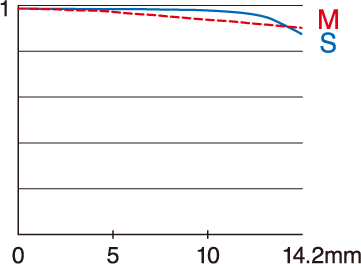 |
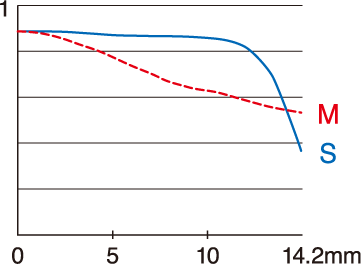 |
MTF at 70mm at f/4 at 15 cycles/mm. |
MTF at 70mm at f/4 at 45 cycles/mm. |
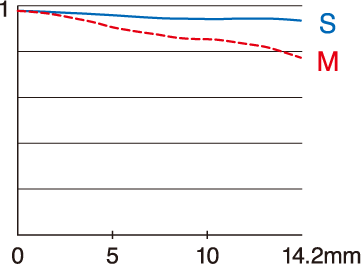 |
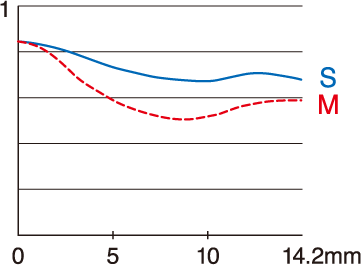 |
MTF at 300mm at f/5.6 at 15 cycles/mm. |
MTF at 300mm at f/5.6 at 45 cycles/mm. |
Spherochromatism performance top
Spherochromatism, also called secondary spherical chromatic aberration or "color bokeh," is an advanced form of spherical and chromatic aberration in a different dimension than lateral chromatic aberration. It happens mostly in fast normal and tele lenses when spherical aberration at the ends of the color spectrum are corrected differently than in the middle of the spectrum. Spherochromatism can cause colored fringes on out-of-focus highlights, usually seen as green fringes on backgrounds and magenta fringes on foregrounds. Spherochromatism is common in fast lenses of moderate focal length when shooting contrasty items at full aperture. It goes away as stopped down.
It has only minor spherochromatism, as expected for a lens this slow:
Mondaine A132.30348.11SBB at close-focus distance at 300mm at f/5.6, 21 May 2021, shot on Fuji X-S10. bigger or camera-original © file.
1,200 × 900 pixel (5.2× magnification) crop from above. bigger or camera-original © file
If this 1,200 × 900 pixel crop is about 3" (7.5cm) wide on your phone, then the complete image printed at this same high magnification would be about 11 × 16" (0.9 × 1.3 feet or 25 × 40 cm).
If this 1,200 × 900 pixel crop is about 6" (15cm) wide on your screen, then the complete image printed at this same very high magnification would be about 21 × 31" (1.7 × 2.6 feet or 50 × 80 cm).
If this 1,200 × 900 pixel crop is about 12" (30cm) wide on your screen, then the complete image printed at this same extreme magnification would be about 42 × 62" (3.5 × 5.2 feet or 1.05 × 1.6 meters).
Image Stabilization performance top
Optical Image Stabilization (OIS, IS or VR (Vibration Reduction)) works very well, with or without in-camera stabilization
"Percent Perfectly Sharp Shots" are the percentage of frames with 100% perfect tripod-equivalent sharpness I get when I'm shooting hand-held while free-standing with no support or bracing. Hand tremor is a random occurrence, so at marginal speeds some frames will be perfectly sharp while others will be in various stages of blur — all at the same shutter speed. This rates what percentage of shots are perfectly sharp, not how sharp are all the frames:
At 70mm on Fuji X-S10 (adds in-camera stabilization)
| % Perfectly Sharp Shots | 1 |
1/2 |
1/4 |
1/8 |
1/15 |
1/30 |
1/60 |
1/125 |
1/250 |
| Stabilization ON | 0 |
5 |
5 |
67 |
67 |
100 |
100 |
100 |
100 |
| Stabilization OFF | 0 |
0 |
0 |
0 |
0 |
17 |
0 |
33 |
83 |
I see 5 stops of real-world stabilization, which is great.
At 150mm on Fuji X-S10 (adds in-camera stabilization)
| % Perfectly Sharp Shots | 1/2 |
1/4 |
1/8 |
1/15 |
1/30 |
1/60 |
1/125 |
1/250 |
1/500 |
| Stabilization ON | 0 |
0 |
0 |
50 |
50 |
67 |
100 |
100 |
100 |
| Stabilization OFF | 0 |
0 |
0 |
0 |
0 |
0 |
17 |
33 |
67 |
I see 4 stops of real-world stabilization, which is very good.
At 300mm on Fuji X-S10 (adds in-camera stabilization)
| % Perfectly Sharp Shots | 1/4 |
1/8 |
1/15 |
1/30 |
1/60 |
1/125 |
1/250 |
1/500 |
1/1,000 |
| Stabilization ON | 0 |
17 |
0 |
17 |
100 |
100 |
100 |
100 |
100 |
| Stabilization OFF | 0 |
0 |
0 |
0 |
0 |
17 |
0 |
67 |
100 |
I see 3 to 3½ stops of real-world stabilization, which is very good.
At 70mm on Fuji X-E4 (no in-camera stabilization)
| % Perfectly Sharp Shots | 1 |
1/2 |
1/4 |
1/8 |
1/15 |
1/30 |
1/60 |
1/125 |
1/250 |
| Stabilization ON | 0 |
0 |
67 |
71 |
71 |
100 |
100 |
100 |
100 |
| Stabilization OFF | 0 |
0 |
0 |
0 |
17 |
50 |
50 |
100 |
100 |
I see about a three stop real-world improvement, which is good.
At 150mm on Fuji X-E4 (no in-camera stabilization)
| % Perfectly Sharp Shots | 1/2 |
1/4 |
1/8 |
1/15 |
1/30 |
1/60 |
1/125 |
1/250 |
1/500 |
| Stabilization ON | 0 |
0 |
0 |
57 |
83 |
100 |
100 |
100 |
100 |
| Stabilization OFF | 0 |
0 |
0 |
0 |
29 |
14 |
100 |
100 |
100 |
I see about a three stop real-world improvement, which is good.
At 300mm on Fuji X-E4 (no in-camera stabilization)
| % Perfectly Sharp Shots | 1/2 |
1/4 |
1/8 |
1/15 |
1/30 |
1/60 |
1/125 |
1/250 |
1/500 |
| Stabilization ON | 0 |
17 |
17 |
57 |
83 |
100 |
100 |
100 |
100 |
| Stabilization OFF | 0 |
0 |
0 |
0 |
0 |
0 |
0 |
50 |
100 |
I see about a 4-stop real world improvement, which is very good.
Sunstars performance top
With a 9-bladed rounded diaphragm I get relatively soft 18-pointed sunstars on brilliant points of light at the smallest apertures.
Ignore the the vertical smear at large apertures, this is is a sensor artifact called interline transfer smear and not a lens defect.
Click any to enlarge:
Click any to enlarge.
Teleconverters performance top
XF 70-300mm works with the FUJINON XF1.4X TC WR and FUJINON XF2X TC WR teleconverters.
Fuji also claims that phase detection autofocus works just as well.
Compared top
Sample Images Intro New Good Bad Missing
Specifications Performance Compared
User's Guide Recommendations More
I'd get my XF 70-300mm at Adorama, at Amazon or at B&H, or used at eBay if you know How to Win at eBay.
This XF 70-300mm is a great lens for all practical purposes, especially if fast autofocus, portability, stabilization and close-focusing are important. The 70-300mm is much smaller and focuses much closer than the XF 100-400mm:
XF 100-400mm R LM OIS WR.
The XF 100-400mm OIS is older, bigger, more expensive and over twice as heavy. I'd get it if I wanted a more serious or longer lens. It can be slightly sharper in the lab as well.
Personally, having both of these at my disposal, I always grab the XF 70-300mm for its convenience. I'd have to be on a pretty serious job to want to carry the XF 100-400mm.
User's Guide top
Sample Images Intro New Good Bad Missing
Specifications Performance Compared
User's Guide Recommendations More
I'd get my XF 70-300mm at Adorama, at Amazon or at B&H, or used at eBay if you know How to Win at eBay.
Fuji XF 70-300mm f/4-5.6 R LM OIS WR. bigger.
Diaphragm / A Switch user's guide top
The diaphragm icon (left) setting means that the aperture may be set by turning the unmarked ring seen here.
The A setting means that the aperture will be controlled either automatically or manually from the camera, rather than by the unmarked ring.
Full / 5m-∞ Switch user's guide top
This is a focus limiter.
Leave it in FULL.
The 5m-∞ position prevents the lens from autofocusing closer than 5 meters (16 feet). Use this setting only if you're having a problem with the lens attempting to focus on irrelevant close items, or if for some reason the lens is "hunting" from near to far looking for distant subjects.
Manual Focus user's guide top
You have to select the focus mode on your camera.
Better Fujifilm APS-C cameras have a dedicated switch on the front of the camera, while crappier ones push this off into the menu system. Sorry.
Manual-Focus Override user's guide top
By default, there is no always-responsive instant manual-focus override as we take for granted in our DSLRs. Good luck.
Stabilizer (OIS) Switches user's guide top
Sadly there are none. Fuji deleted them.
You have to find this now in your camera's menu system.
Recommendations top
Sample Images Intro New Good Bad Missing
Specifications Performance Compared
User's Guide Recommendations More
I'd get my XF 70-300mm at Adorama, at Amazon or at B&H, or used at eBay if you know How to Win at eBay.
I'm amazed that I never noticed that Fuji's lineup was missing such a great and practical mid- to long-telephoto zoom. Every Fuji X shooter should have one of these! It's moderately sized and priced and a joy to use for everything that warrants a long lens.
I use a clear (UV) protective filter instead of a cap so I'm always ready to shoot instantly. I only use a cap when I throw this in a bag with other gear without padding — which is never. The UV filter never gets in the way, and never gets lost, either.
The very best protective filter is the Hoya multicoated HD3 67mm UV which uses hardened glass and repels dirt and fingerprints.
For less money, the B+W 67mm 010 is an excellent filter, as are the multicoated version and the basic multicoated Hoya filters, but the Hoya HD3 is the toughest and the best.
If I was working in nasty, dirty areas, I'd forget the cap, and use an uncoated 67mm Tiffen UV filter instead. Uncoated filters are much easier to clean, but more prone to ghosting.
Filters last a lifetime, so you may as well get the best. The Hoya HD3 stays cleaner than the others since it repels oil and dirt.
All these filters are just as sharp and take the same pictures, the difference is how much abuse they'll take and stay clean and stay in one piece. Since filters last a lifetime or more, there's no reason not to buy the best as it will last you for the next 40 years. Filters aren't throwaways like digital cameras which we replace every few years, like it or not. I'm still using filters I bought back in the 1970s!
I'd get my XF 70-300mm at Adorama, at Amazon or at B&H, or used at eBay if you know How to Win at eBay.
This 100% all-content, junk-free website's biggest source of support is when you use those or any of these links to my personally approved sources I've used myself for way over 100 combined years when you get anything, regardless of the country in which you live — but I receive nothing for my efforts if you get it elsewhere. Fuji does not seal its boxes in any way, so never buy at retail or any other source not on my personally approved list since you'll have no way of knowing if you're missing accessories, getting a defective, damaged, returned, dropped, incomplete, gray-market, store demo or used lens — and all of my personally approved sources allow for 100% cash-back returns for at least 30 days if you don't love your new lens. I've used many of these sources since the 1970s because I can try it in my own hands and return it if I don't love it, and because they ship from secure remote warehouses where no one gets to touch your new lens before you do. Buy only from the approved sources I've used myself for decades for the best prices, service, return policies and selection.
Thanks for helping me help you!
Ken.
More Information top
Sample Images Intro New Good Bad Missing
Specifications Performance Compared
User's Guide Recommendations More
I'd get my XF 70-300mm at Adorama, at Amazon or at B&H, or used at eBay if you know How to Win at eBay.
Fujifilm's 70-300mm press release.
© Ken Rockwell. All rights reserved. Tous droits réservés. Alle Rechte vorbehalten. Ken Rockwell® is a registered trademark.
Help Me Help You top
I support my growing family through this website, as crazy as it might seem.
The biggest help is when you use any of these links when you get anything. It costs you nothing, and is this site's, and thus my family's, biggest source of support. These places always have the best prices and service, which is why I've used them since before this website existed. I recommend them all personally.
If you find this page as helpful as a book you might have had to buy or a workshop you may have had to take, feel free to help me continue helping everyone.
If you've gotten your gear through one of my links or helped otherwise, you're family. It's great people like you who allow me to keep adding to this site full-time. Thanks!
If you haven't helped yet, please do, and consider helping me with a gift of $5.00.
As this page is copyrighted and formally registered, it is unlawful to make copies, especially in the form of printouts for personal use. If you wish to make a printout for personal use, you are granted one-time permission only if you PayPal me $5.00 per printout or part thereof. Thank you!
Thanks for reading!
Ken.
